After the ship had docked in the port on Porto Santo island and we had disembarked, we walked to the capital of the island called Vila Baleira, since this was a nice walk of some 15-20 minutes.
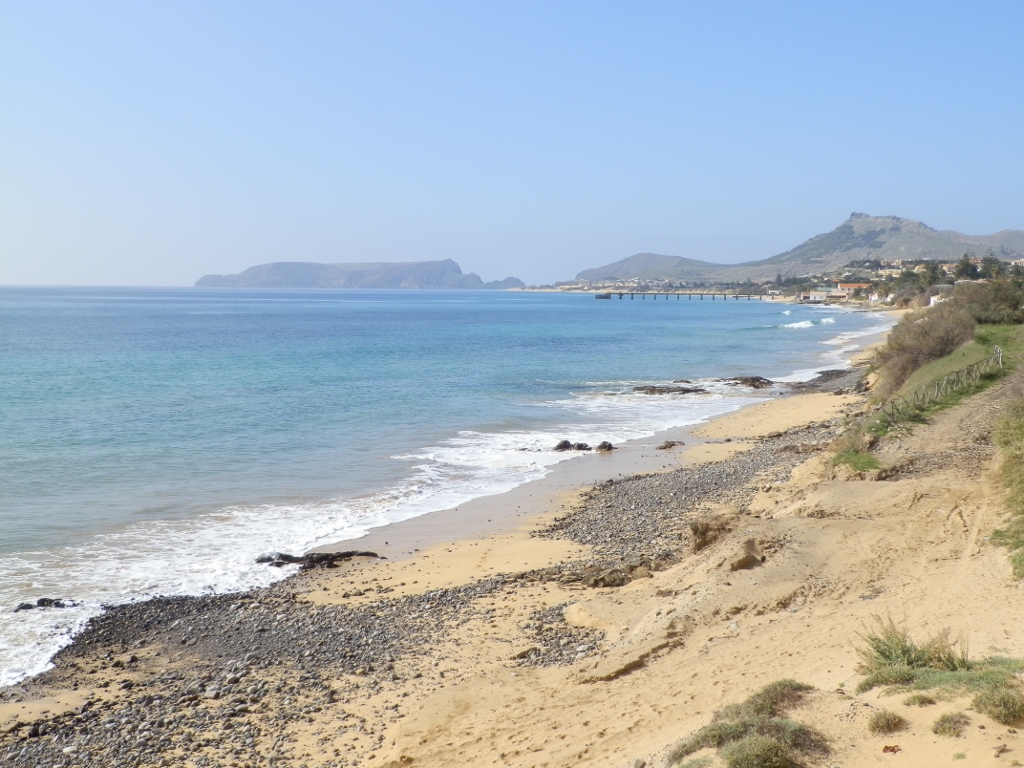 We have landed
We have landed
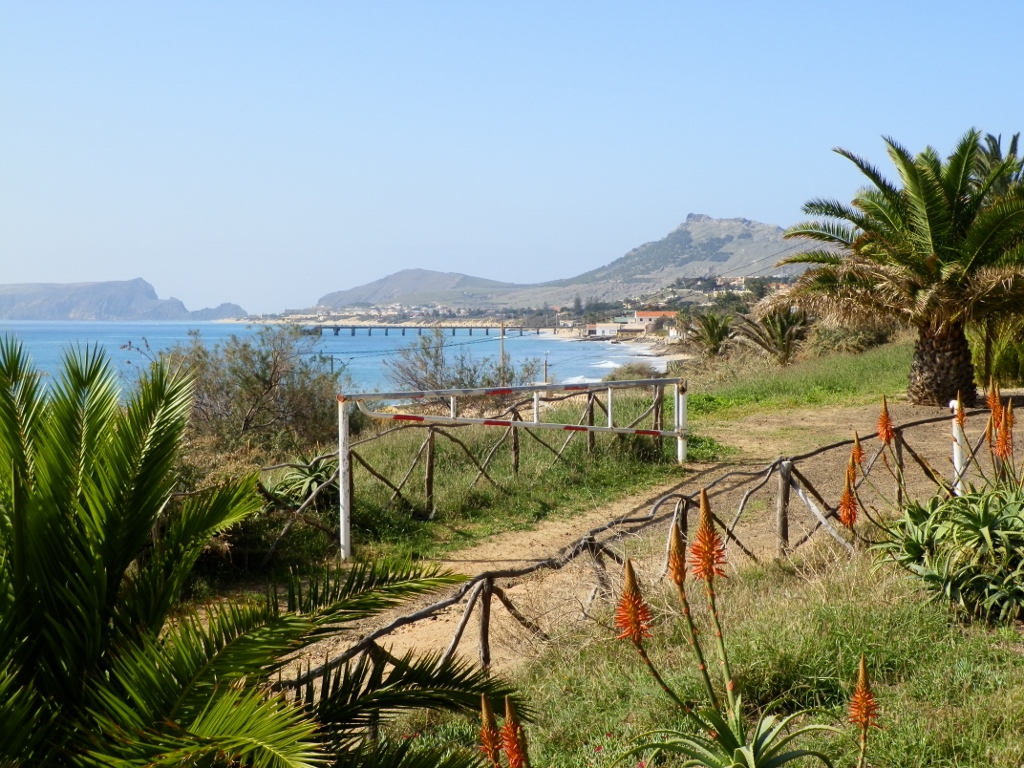 Land on Porto Santo island
Land on Porto Santo island
I have already mentioned earlier that in 1418 Portuguese navigator João Gonçalves Zarco was storm blown to an island in the Atlantic by which he was practically saved and so he named the until then unknown island – “Holy Harbour” (Porto Santo). Today, this island belongs to the Autonomous Region Madeira. Roughly speaking, the island has a shape of a bean and on its “interior” side there is a long sandy beach.
Still, Joao and I first headed not for the beach, but for the centre of Vila Baleira since I felt the need for legal stimuli. Namely, as I had not slept well the night before, plus I felt like my blood pressure had collapsed, I felt particularly heavy, slow and lazy, so much so that I didn’t feel like chatting (there is a first time for everything). So, we went to a café in the centre where I ordered both a coca-cola and a garoto (Portuguese espresso with milk, more like a small cappuccino), my head was in the shade and my legs were in the sun, and all of that felt nice, so I finally started to wake up properly.
When I finally went back to my normal operating mood, we started with a leisurely walk around the centre of the place. Vila Baleira is actually a lovely village that was only in 1996 declared a city (I guess this has something to do with the administrative and parish status).
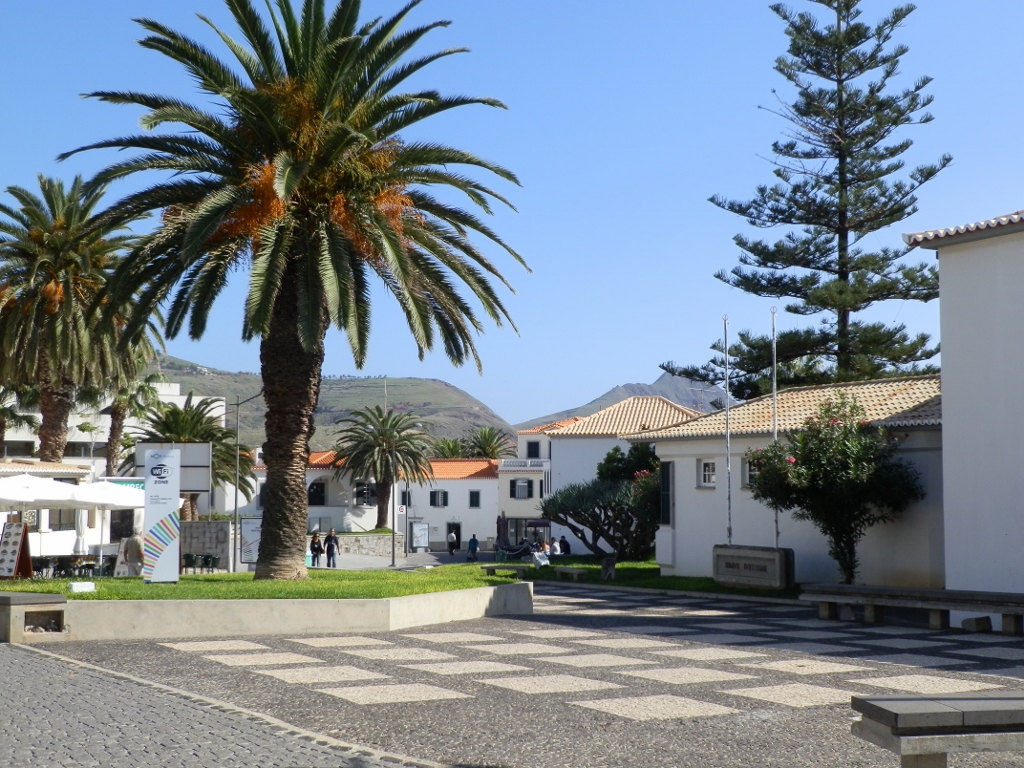 Part of the centre of Vila Baleira
Part of the centre of Vila Baleira
In the lovely Pelourinho Square (Largo do Pelourinho) there is the Old Town Hall along with several specimens of the Canary Islands dragon tree (Dracaena draco), a species of subtropical trees endemic on Madeira and a few other places.
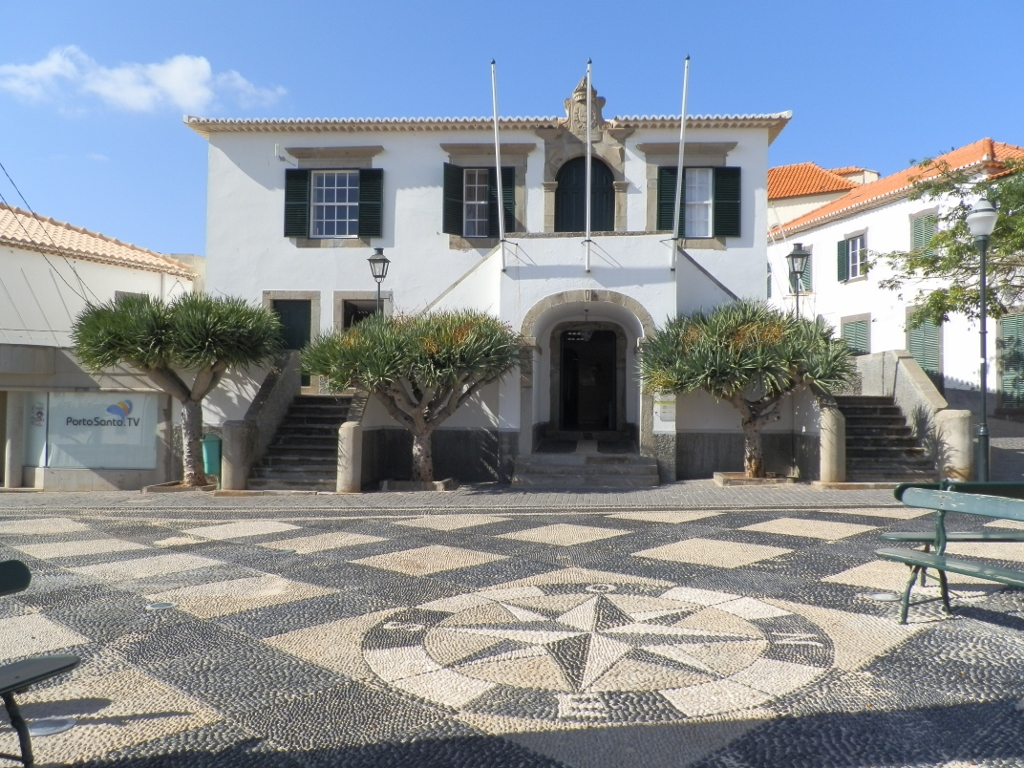 Old Town Hall and the Canary Islands dragon tree
Old Town Hall and the Canary Islands dragon tree
At the Pelourinho Square there are a few fenced off and protected cereal bunkers called matamorra. These are cylindrical silos dug into the earth. There are in fact five of them in the square and they were used to store the cereal grown on the island, as well as for the residents to hide in them when pirates would attack the island.
From the square one can see nicely the lateral side of the Church of Our Lady of Piety (Igreja de Nossa Senhora da Piedade). In the first half of the 15th century, the first chapel on the island was built on this spot, but it was burned down by pirates in 1667. The church that can be seen today in Vila Baleira was built later on.
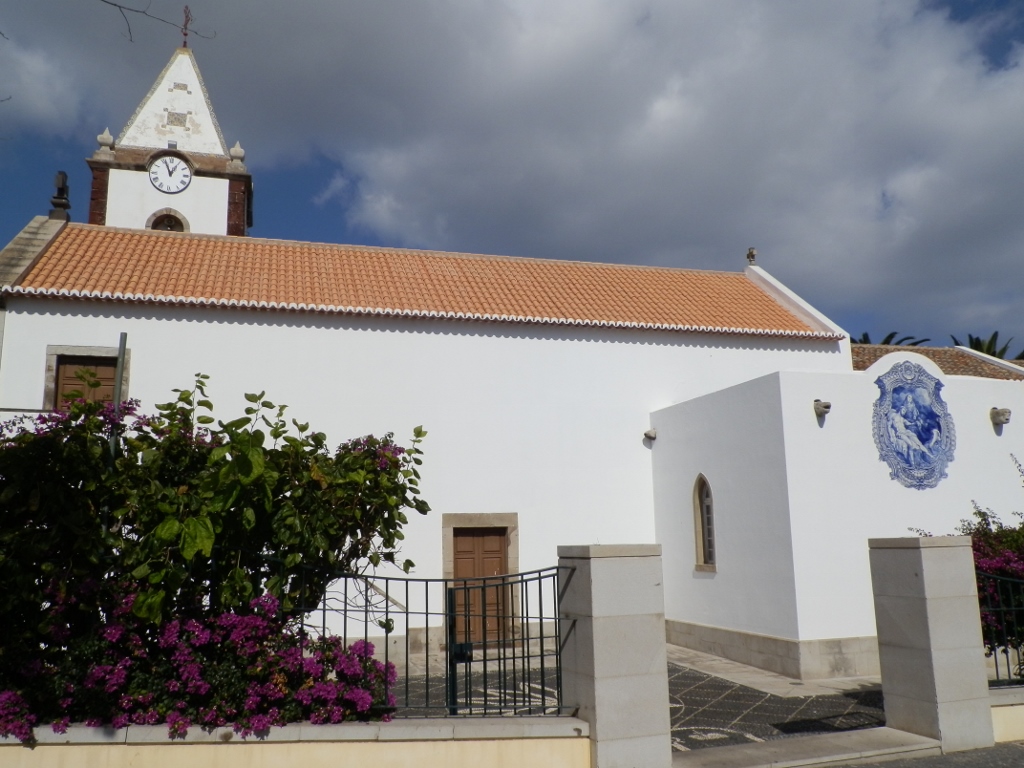 Our Lady of Piety
Our Lady of Piety
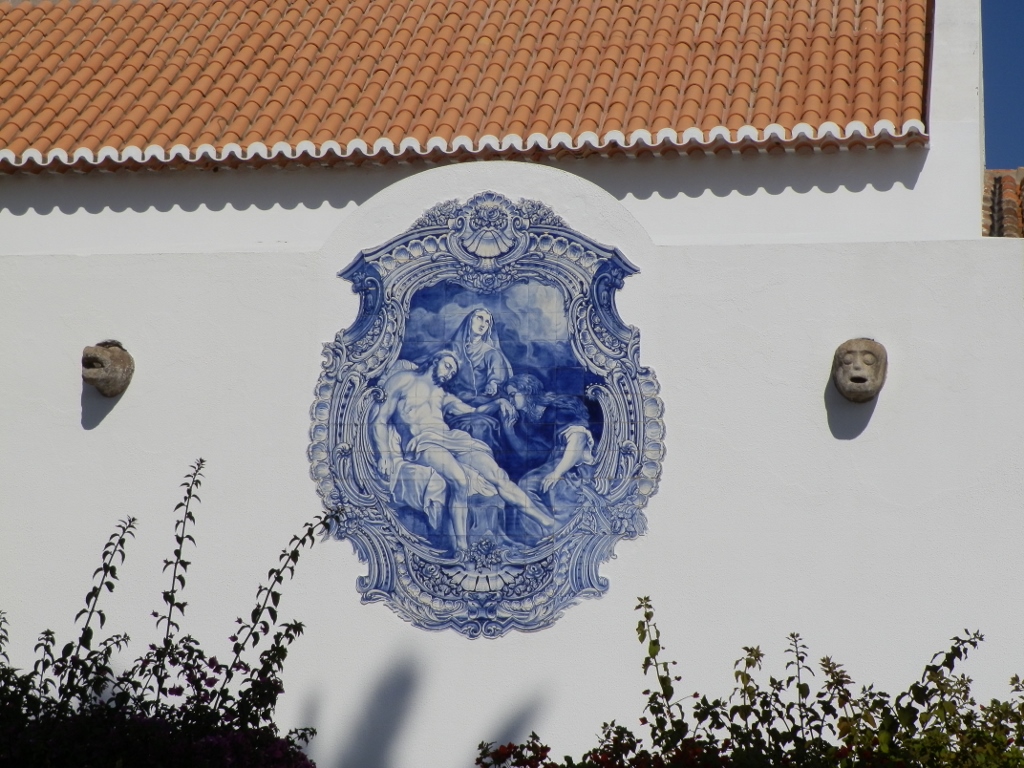 The pietà motif on an exterior wall done in the azulejo tiles
The pietà motif on an exterior wall done in the azulejo tiles
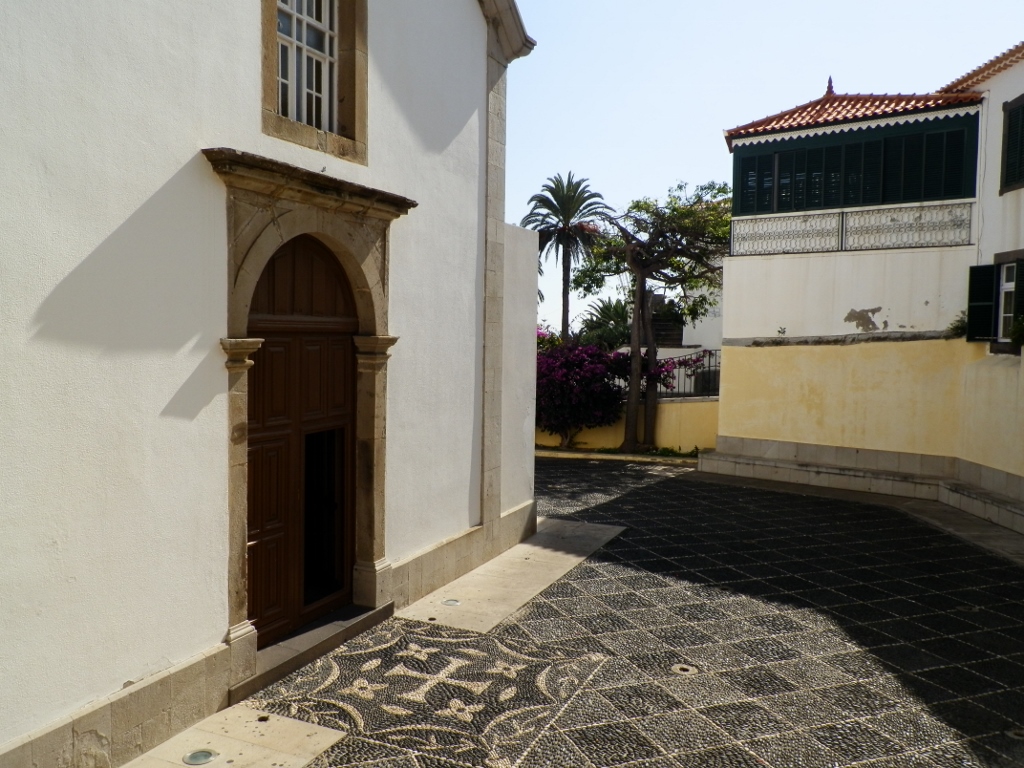 Our Lady of Piety: the entrance
Our Lady of Piety: the entrance
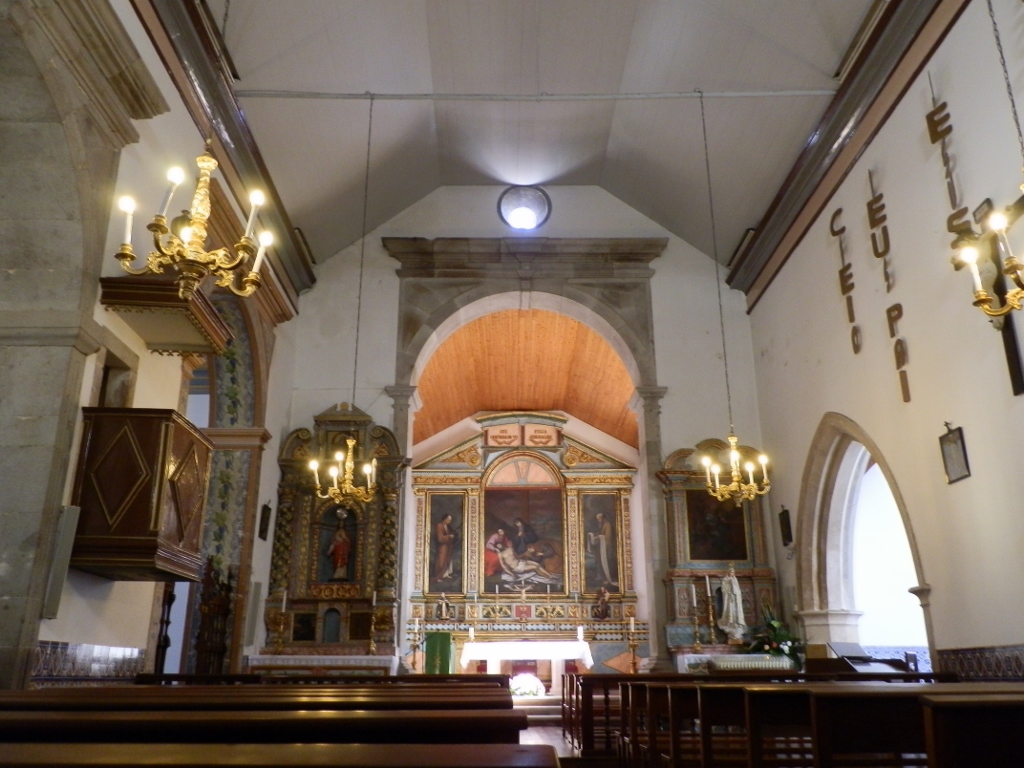 Our Lady of Piety: the interior
Our Lady of Piety: the interior
Close to the church there is the Christopher Columbus House Museum. Namely, the wife of Christopher Columbus was a noblewoman, Filipa Moniz Perestrelo, born here on Porto Santo island. It is believed that on the occasion of the wedding that took place in Vila Baleira Christopher Columbus stayed precisely in this house where nowadays there is the museum.
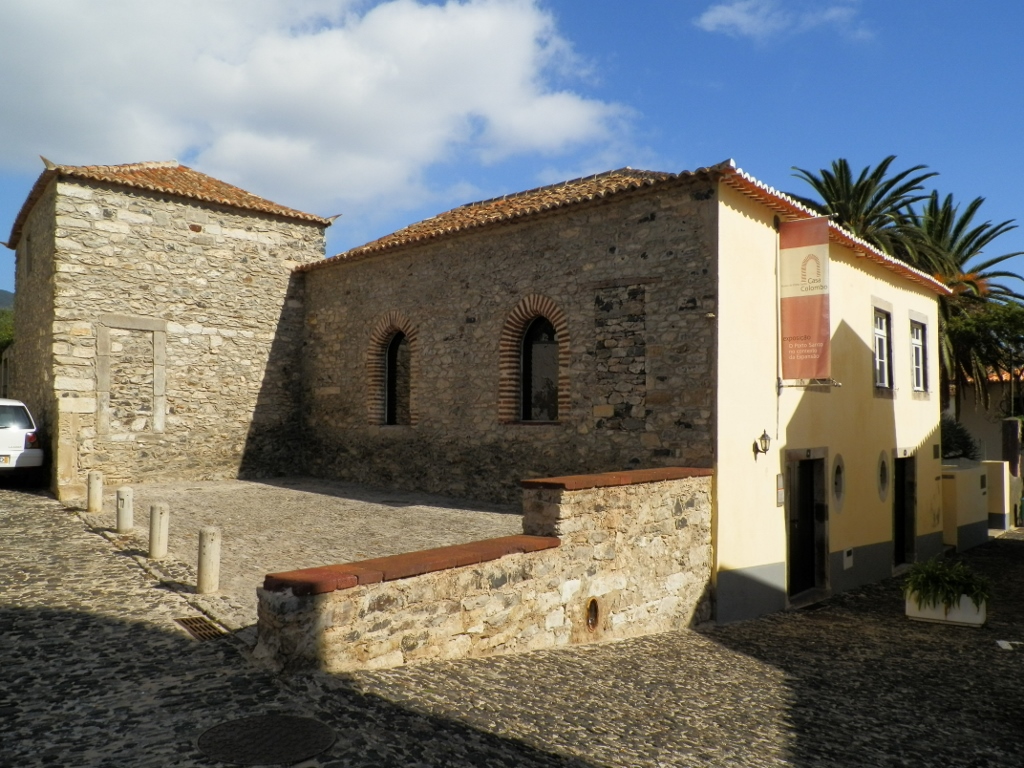 The Christopher Columbus House Museum
The Christopher Columbus House Museum
Still, I was not too keen on visiting the museum and instead Joao and I continued with a relaxed walk around the place. Thus we got to a street from which there is a fine view at the Castle Peak (Pico do Castelo) 437 metres high. I think that judging by the shape I could calmly conclude that this is an (extinct) volcano.
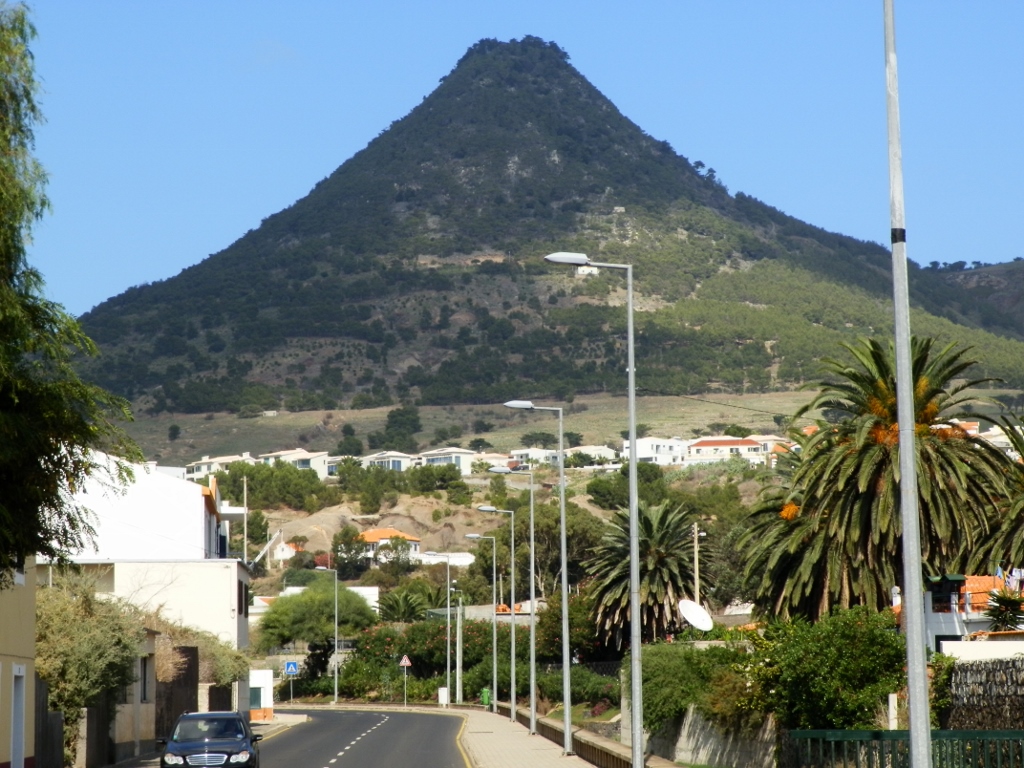 Pico do Castelo
Pico do Castelo
Although there is much less greenery on Porto Santo than on Madeira and historically speaking there was a big problem with drinking water here, judging by the well built and deep canal for the flowing of a small local river that we passed by, it was obvious that there may be strong torrents when there are heavy rains here.
However, on this day the weather was perfect – sunny, warm, but absolutely not hot. In other words, ideal for going to a beach.
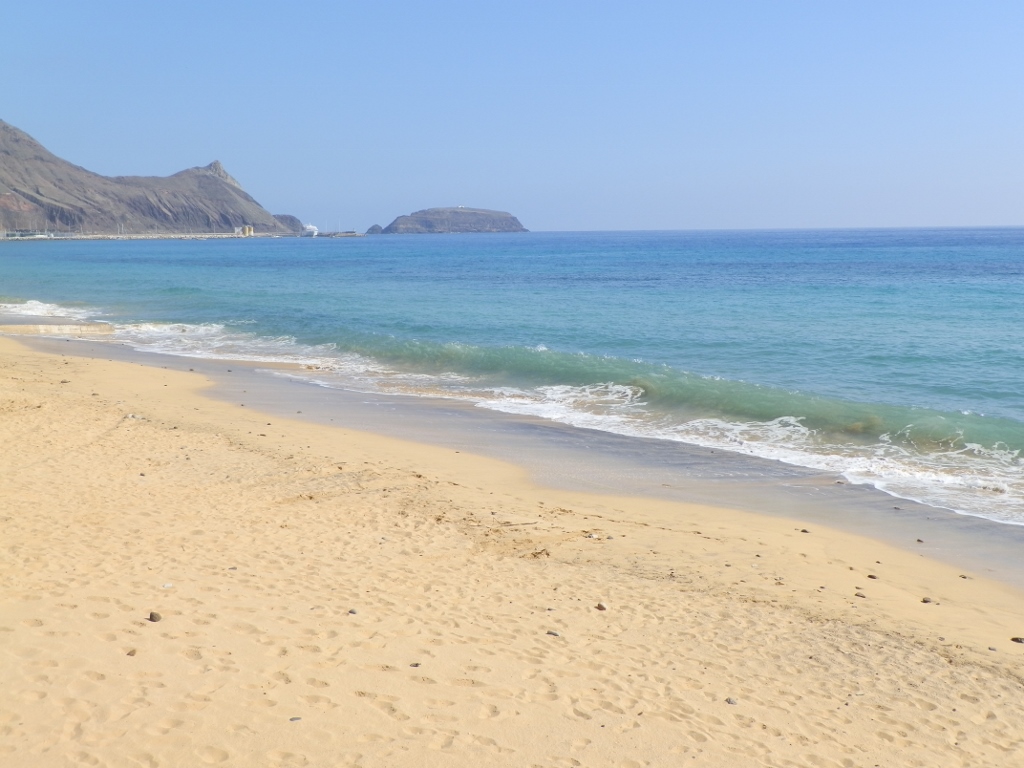 Beach on Porto Santo
Beach on Porto Santo
The beach on Porto Santo island is sandy (as opposed to the natural beaches on Madeira). In addition, it is also very long, whole 9 km, and goes from the port on the east side of the island until the island’s final southwest tip. The main season is in July, August and September. Everything is more expensive then and the crowds are apparently enormous. Joao used to come here as a child. His father had a house here, so they spent their summer holidays on the island. Still, in November, there was almost nobody on the beach and it was wonderful to walk there. Since I took my shoes off and went into the water a little, I can report that it was very cold.
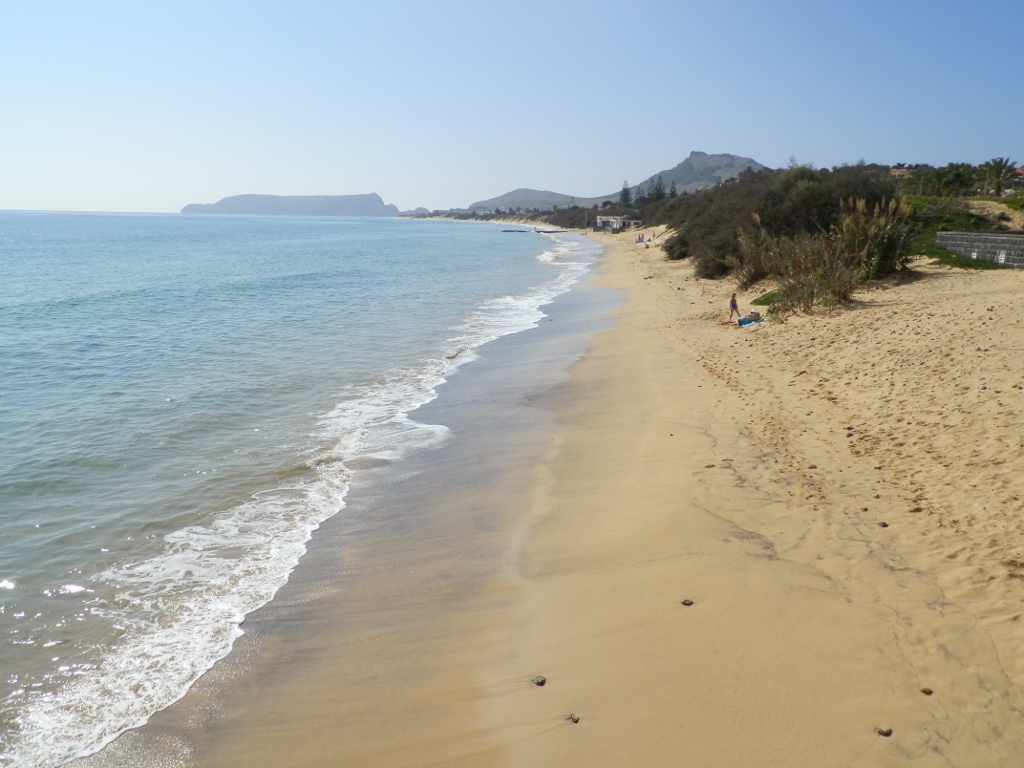 Beach on Porto Santo
Beach on Porto Santo
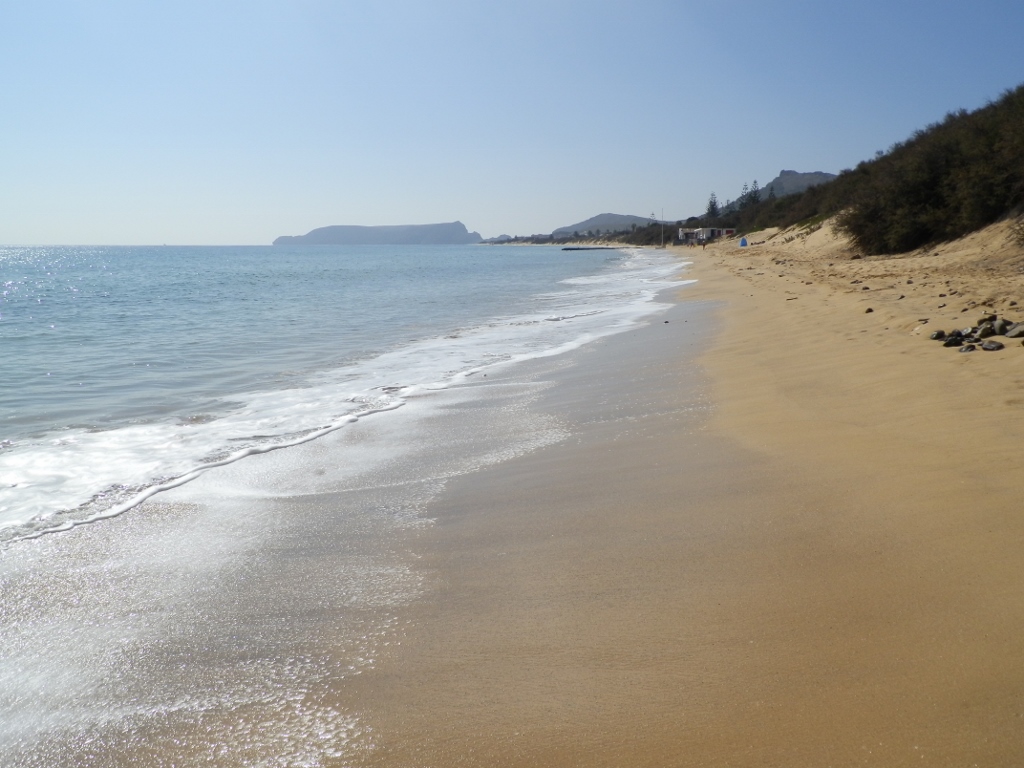 Beach on Porto Santo
Beach on Porto Santo
Then we got to a jetty called the Wharf of Porto Santo (Cais do Porto Santo). Its construction started in 1929 and in the past it was used for the throughflow of people and goods, while today it is a kind of a historic monument. But, this is primarily a great place for one to walk to its end since it offers some great views.
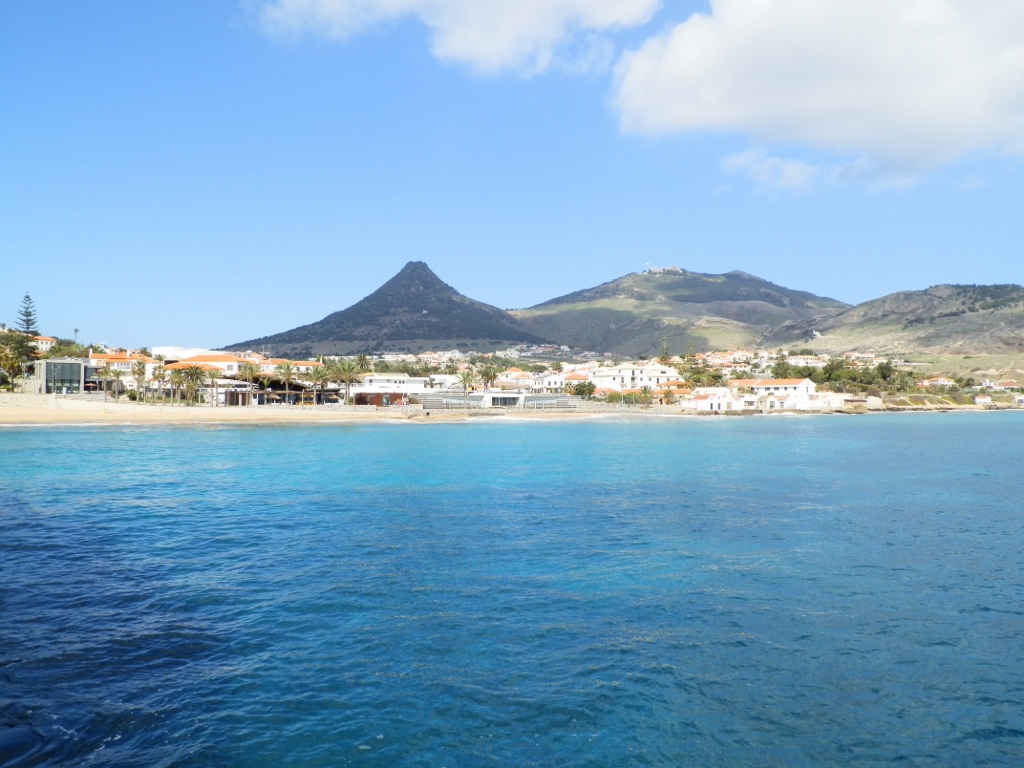 View at Vila Baleira and Pico do Castelo
View at Vila Baleira and Pico do Castelo
And the colour of the water... I would have probably frozen had I jumped in, but it was truly inspiring.
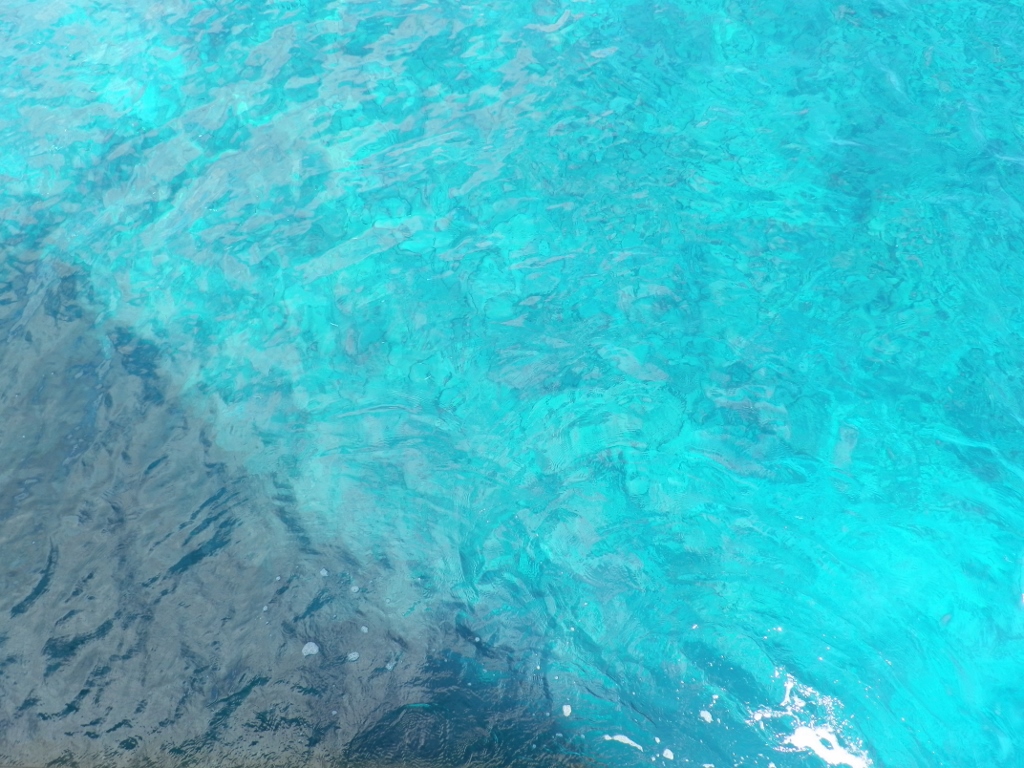 Who would have said this was the Atlantic Ocean?
Who would have said this was the Atlantic Ocean?
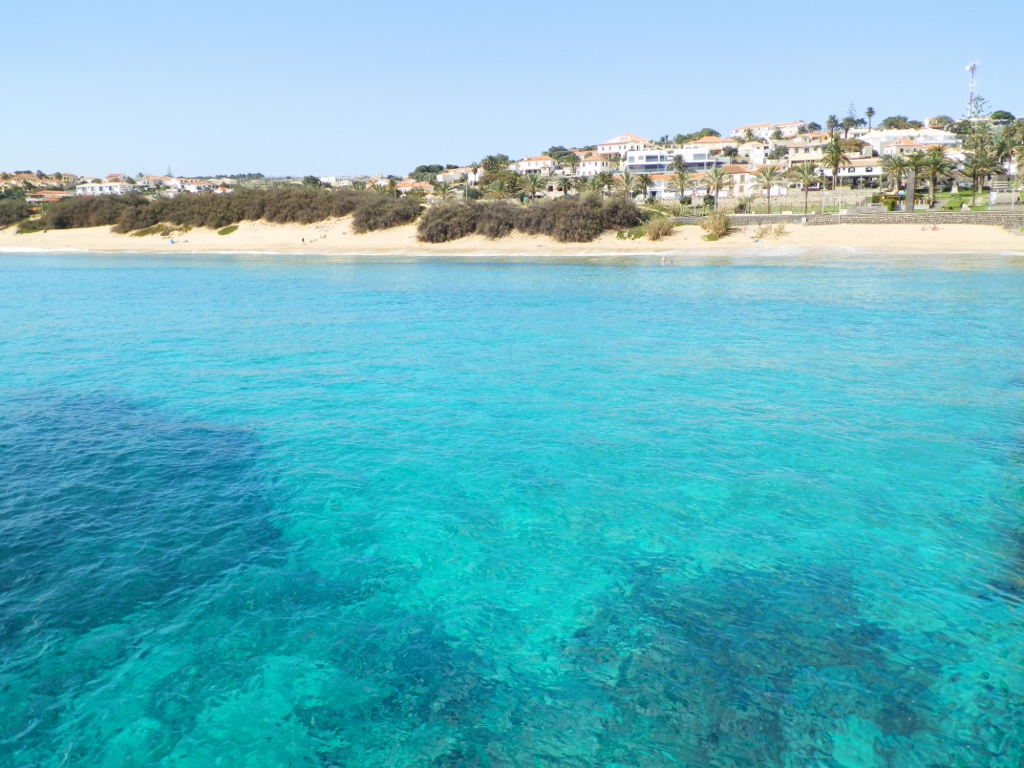 Who would have said this was the Atlantic Ocean?
Who would have said this was the Atlantic Ocean?
Then we returned to the shore with one more looking back at the Wharf of Porto Santo.
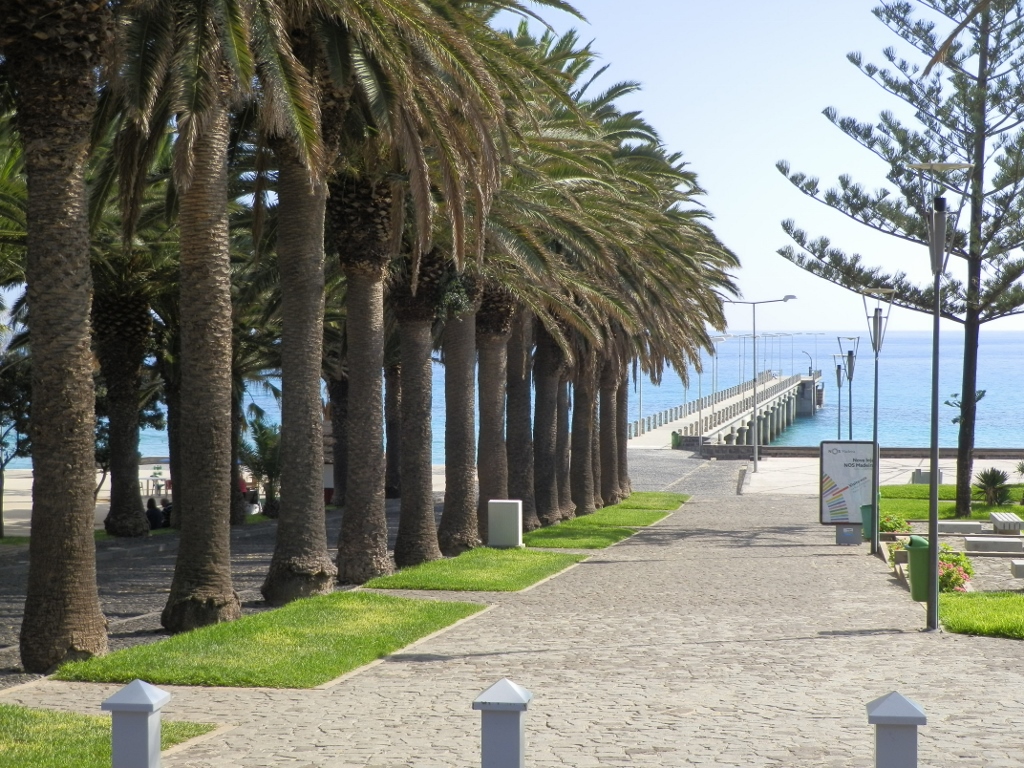 Cais do Porto Santo
Cais do Porto Santo
Bearing in mind the leisurely walk and the time that passed in this activity, there was a slight problem in the shape of food. Namely, Joao and I had already agreed that at 3 pm we would go on a tourist visit to the island, but this did not leave us with sufficient time for a normal lunch. So, we had to improvise, which was not too hard. In the end, we were full enough, without losing anything from the pleasant sightseeing.
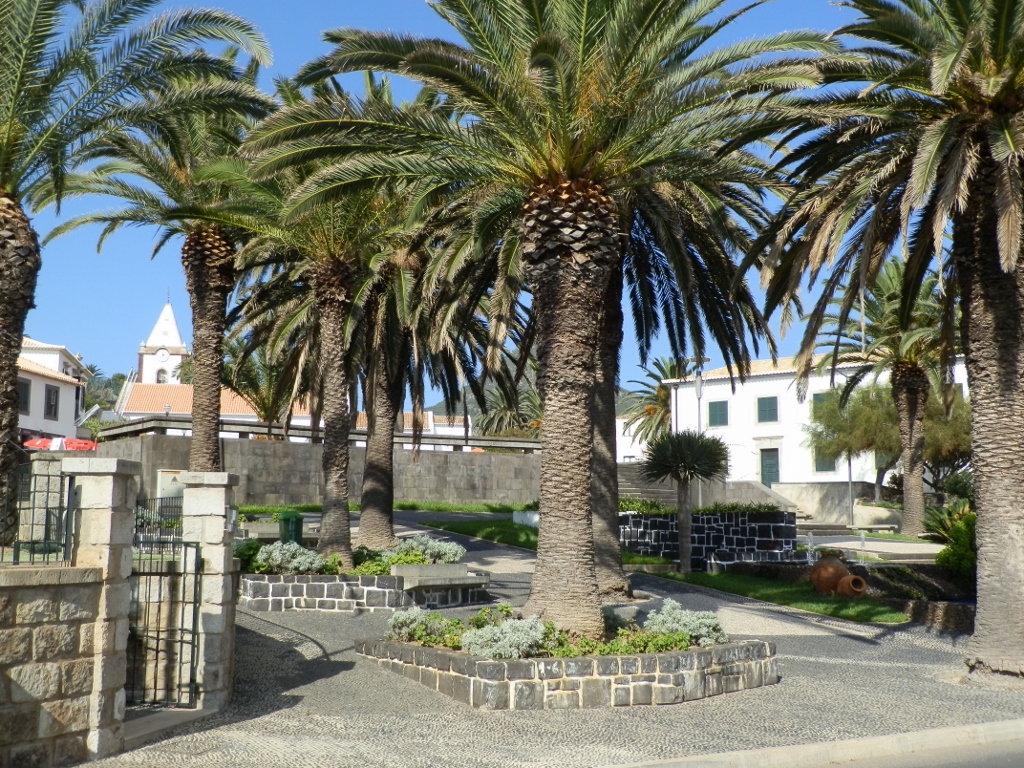 Part of the centre of Vila Baleira
Part of the centre of Vila Baleira
At 3 pm we started with the tour of the island in an open tourist bus that was to last for almost two hours. The first destination was a promontory at the very southwest of the island – Ponta da Calheta. This is precisely the spot until which the beach of Porto Santo extends.
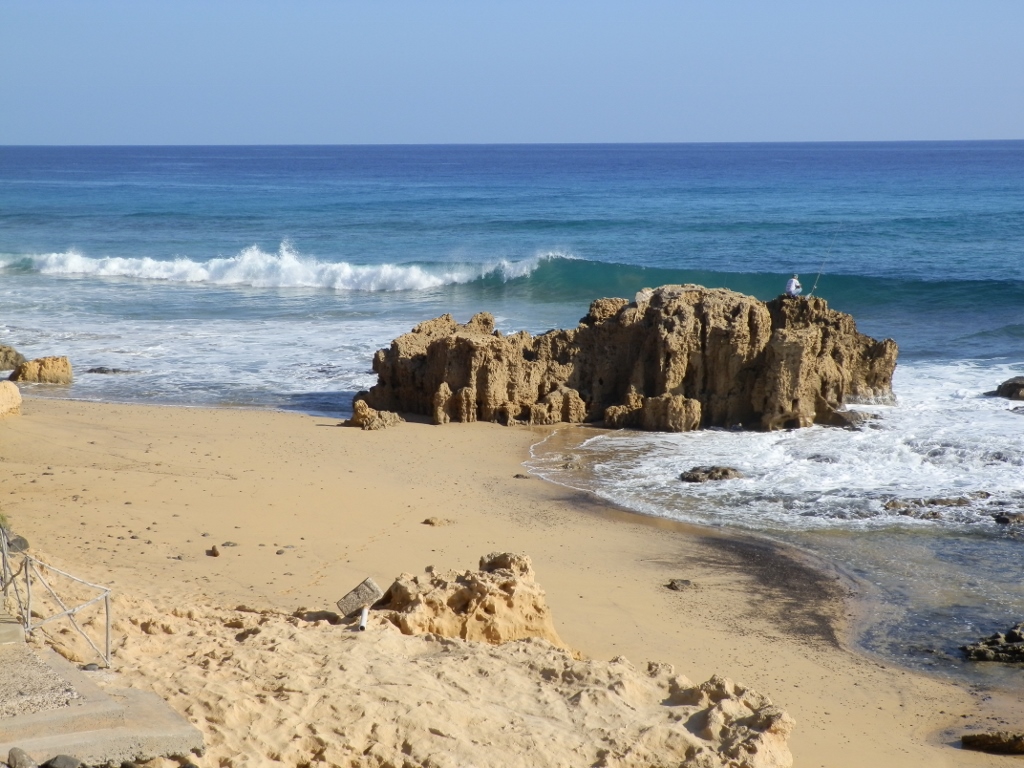 This is the end of the sand beach and where the rocks start
This is the end of the sand beach and where the rocks start
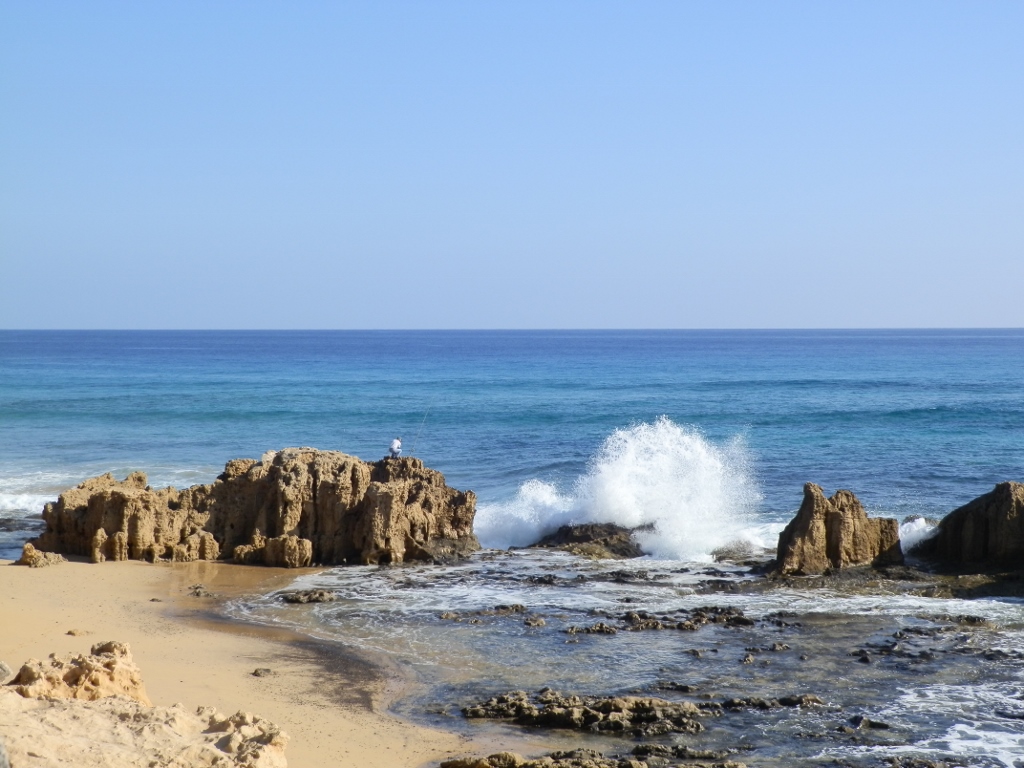 This is the end of the sand beach and where the rocks start
This is the end of the sand beach and where the rocks start
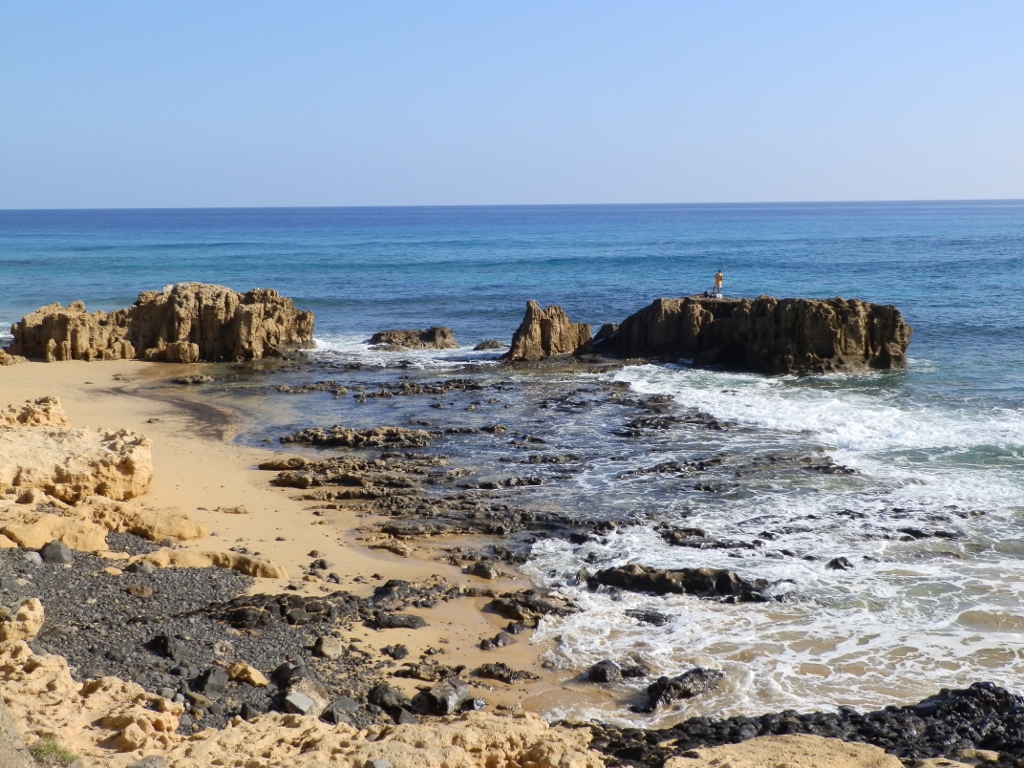 This is the end of the sand beach and where the rocks start
This is the end of the sand beach and where the rocks start
Across this promontory there is an uninhabited Cal Islet (Ilhéu da Cal), but it is obvious that there are a lot of fish here, for we could see anglers all over the rocks.
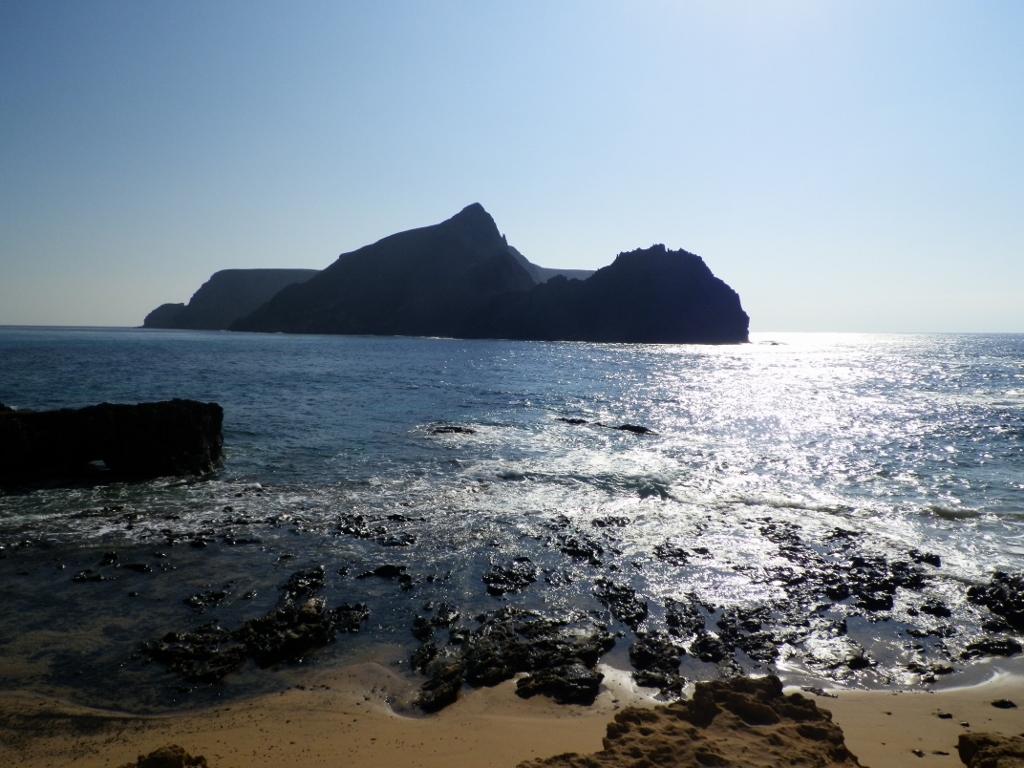 Cal Islet
Cal Islet
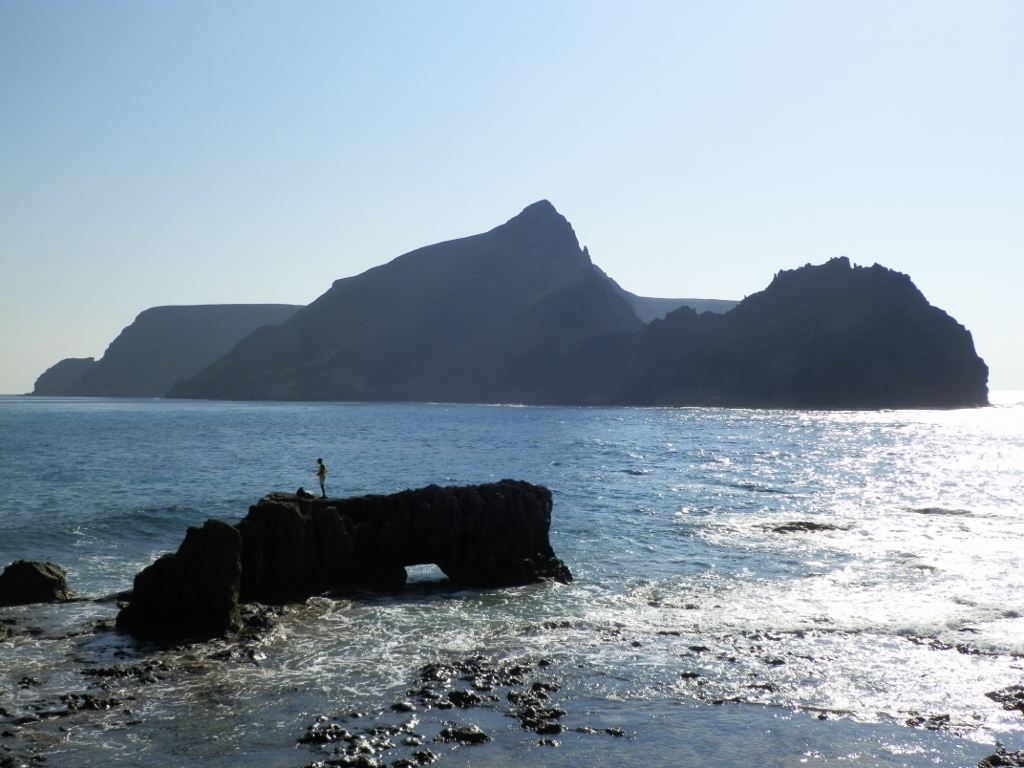 Fishing between Porto Santo and Cal Islet
Fishing between Porto Santo and Cal Islet
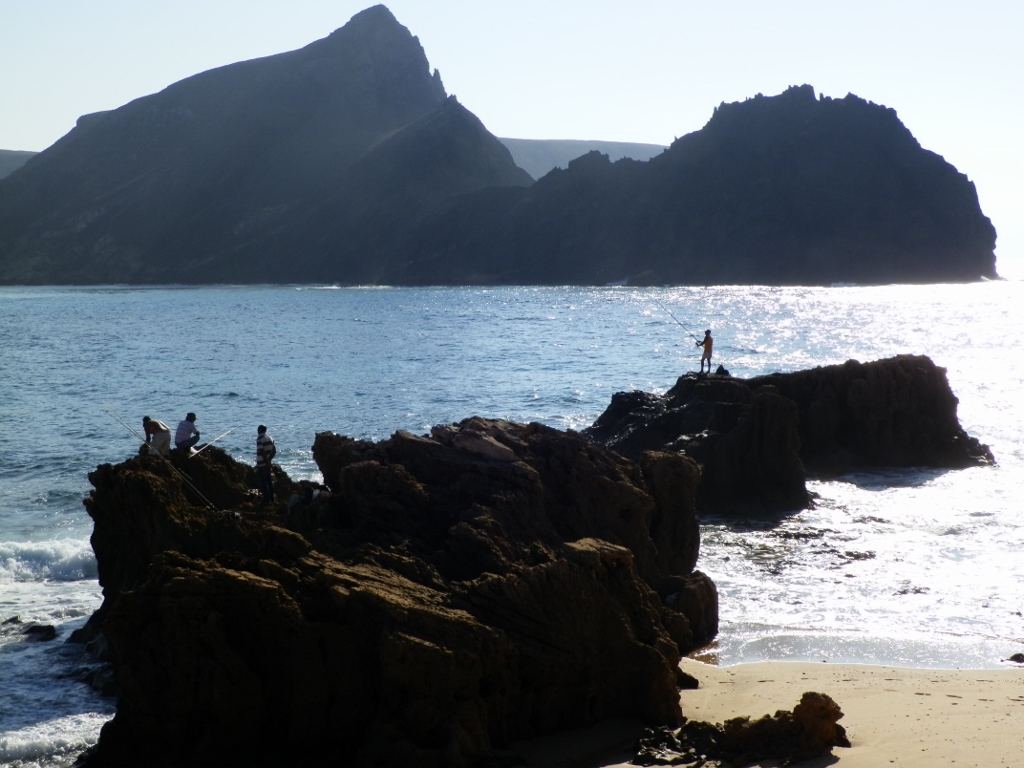 Fishing between Porto Santo and Cal Islet
Fishing between Porto Santo and Cal Islet
After the break for visiting this place, we got on the tourist bus again and continued with the tour, this time driving in the opposite direction.
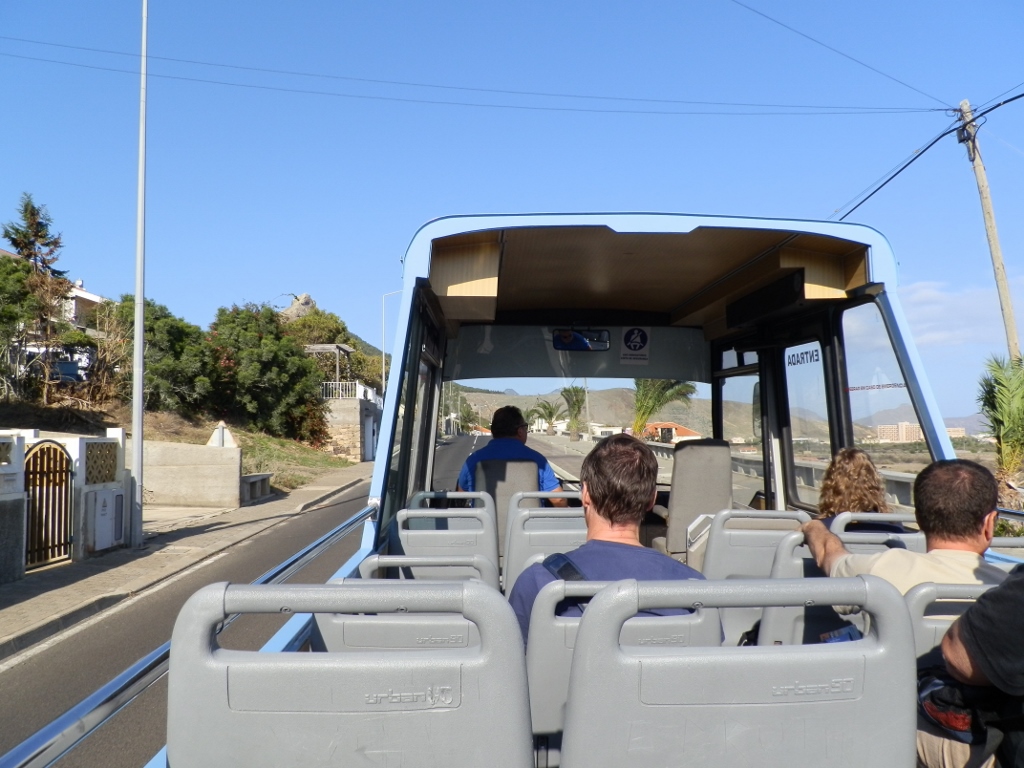 Tourist bus for visiting Porto Santo island
Tourist bus for visiting Porto Santo island
This sightseeing tour by the open bus was a very nice thing. One practically sees the entire island. We passed by houses, but we drove past fields with crops as well. Then we also passed beside the airport. Namely, there is an airport on the island and one can come here also by flying from Madeira. Officially the flight takes around 25 minutes, but the flying length takes half the time.
In the continuation of the tour, the bus drove around the airport and went to the north side of the island where there is a fine Fonte da Areia Viewpoint (Miradouro da Fonte da Areia). We made a photo break there. From the viewpoint it is possible to see the rocky north coast of the island, as a contrast to the peaceful sandy beach on the south side, as well as a rocky islets that protrudes from the Atlantic – Ilheu Da Fonte Da Areia.
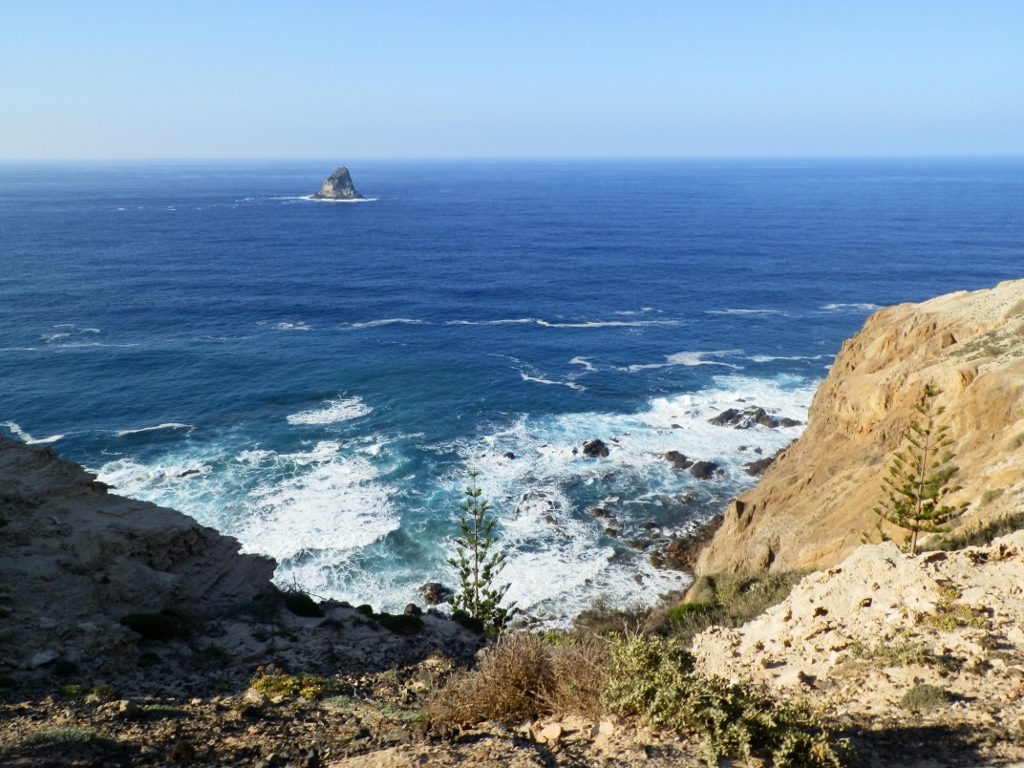 Fonte da Areia Viewpoint
Fonte da Areia Viewpoint
After this we drove to Pico do Castelo. Not all the way to the peak, but to a picnic area close to the top. I was quite impressed with how they had made barbeque slots and there were even water outlets.
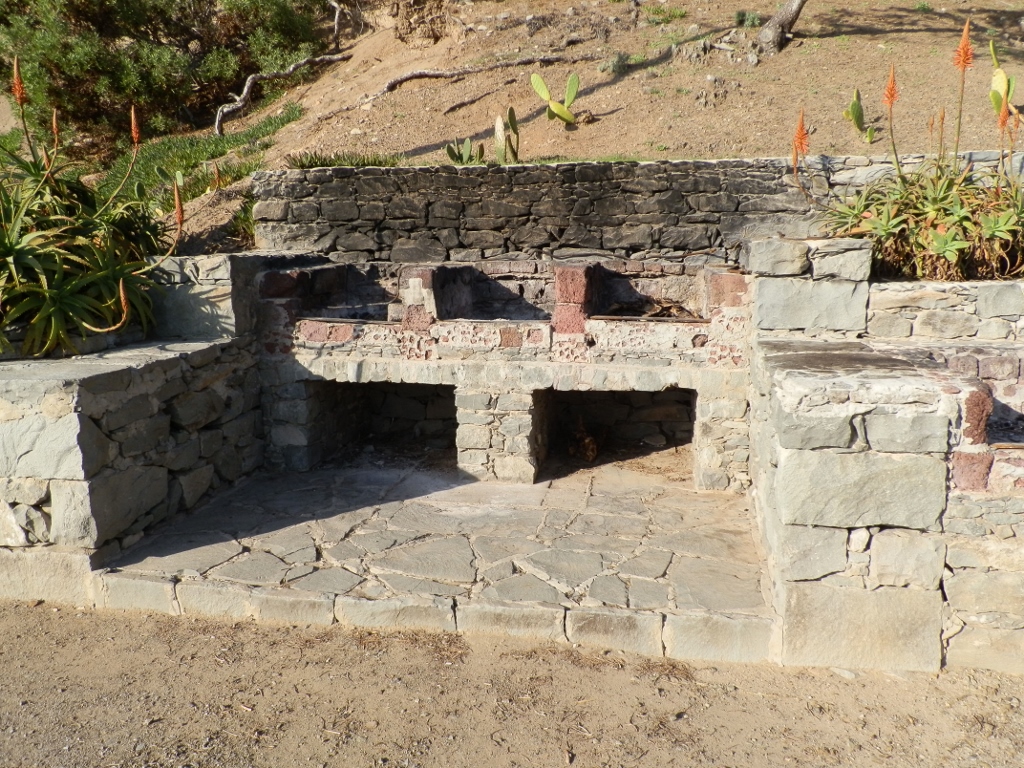 Stone grills in the picnic area of Pico do Castelo
Stone grills in the picnic area of Pico do Castelo
However, what makes this place much more interesting is the stunning view that one can enjoy from a plateau that exists here.
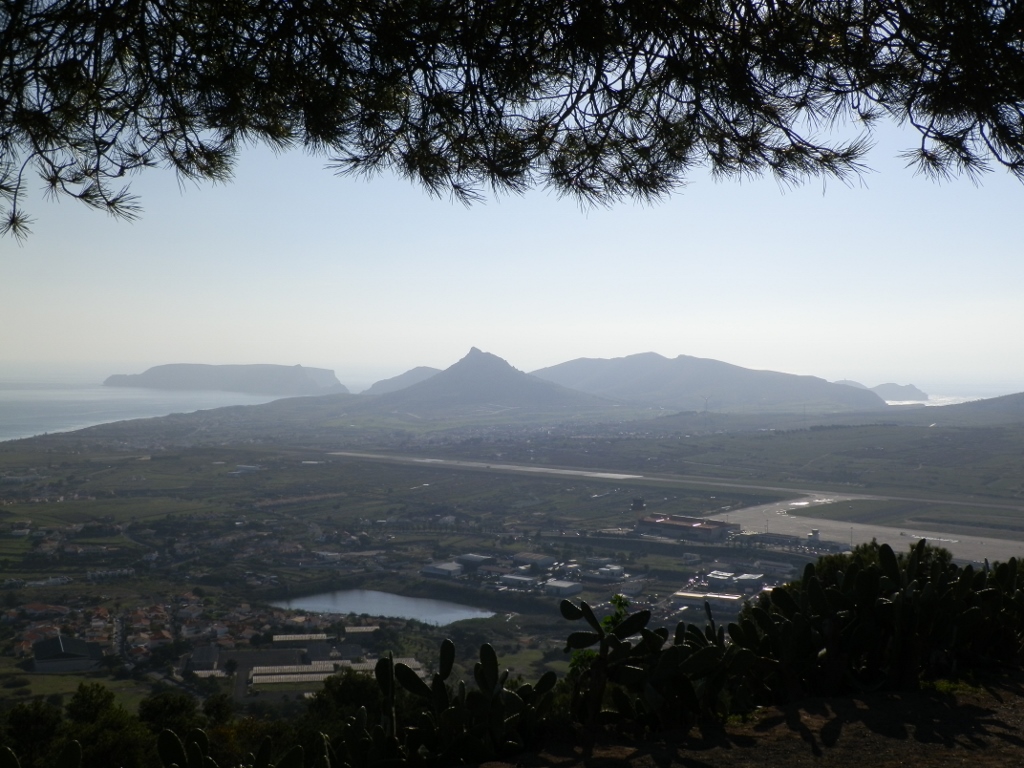 Porto Santo island (the airport runway can be seen to the right and in the middle)
Porto Santo island (the airport runway can be seen to the right and in the middle)
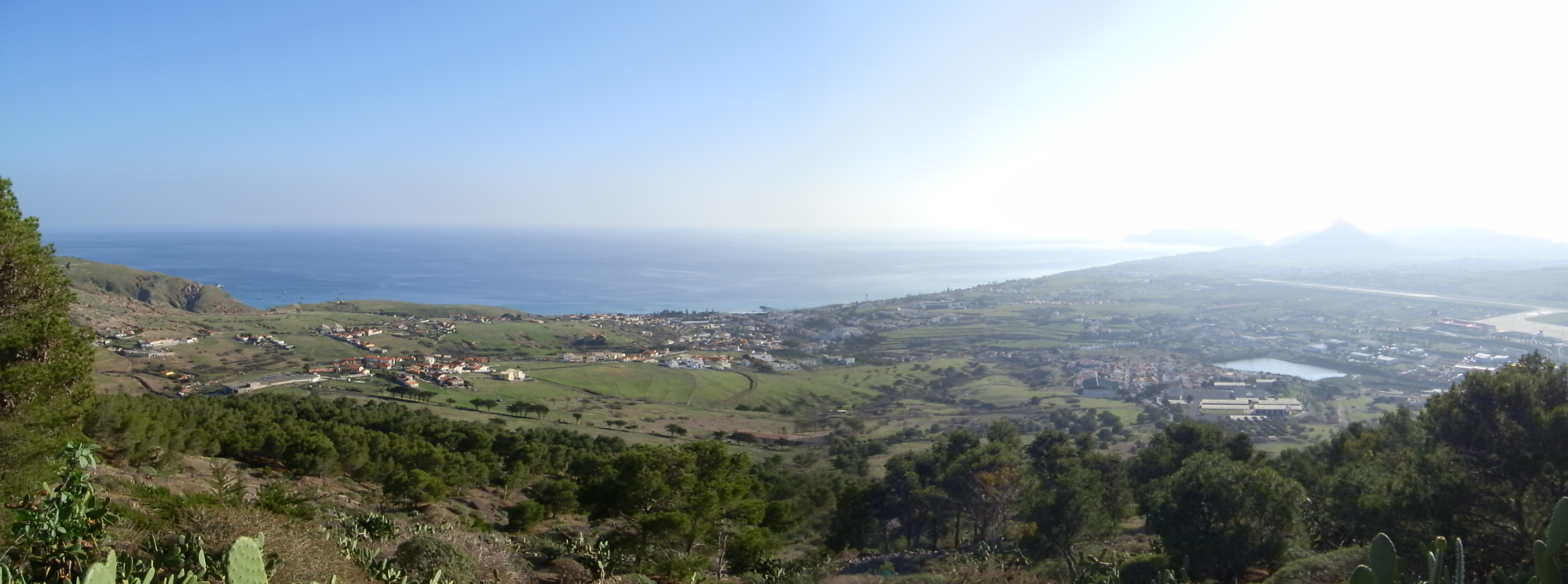
There are also remains of a 16th century fortress here, since the island was continuously targeted by pirates in the past. The whole hill was in fact named after this fortress. Namely, Portuguese Castelo is derived from Latin castellum meaning a small, isolated fort.
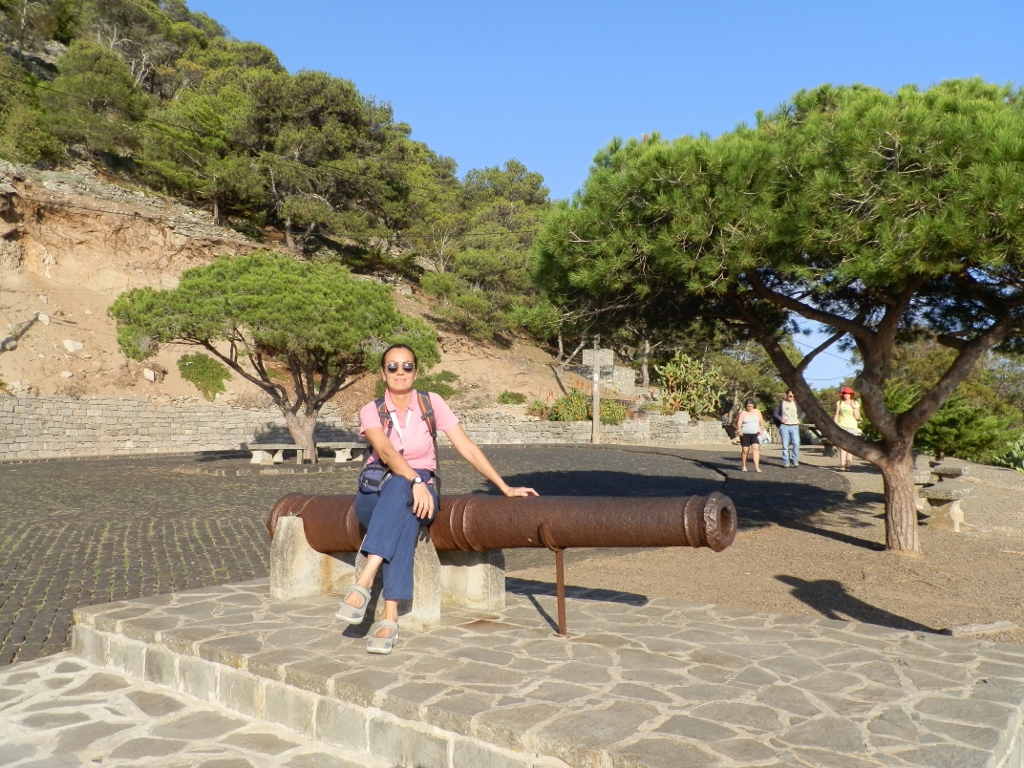 Posing with an old cannon
Posing with an old cannon
We continued with our sightseeing from here, but at some point the bus kept jolting a little, so I joked inside of my head thinking that this would be a good opportunity to tell the driver that we are not bags of potatoes (this is a typical jocular remark used in Serbia in similar situations). Then I concluded I could not say this to the driver after all because I did not speak Portuguese. And yet... And yet, in the meantime I had learned to say: “Pode mi trazer um copo de água?” – Could you bring me a glass of water? With a mandatory “Muito obrigada” (Thank you very much), which I had known from before. Every time I would say this, Joao doubled with laughter, for I was probably pronouncing it funnily, but to me my Portuguese sounded fabulous. On the other hand, the important thing was that the two of us still kept having good time.
Our next destination and the place for taking photos was the Portela Viewpoint (Miradouro da Portela). This is an absolutely great place. From here it was possible to see well the east side of the island, the port and also how the beach starts from the breakwater and then extends for those 9 km.
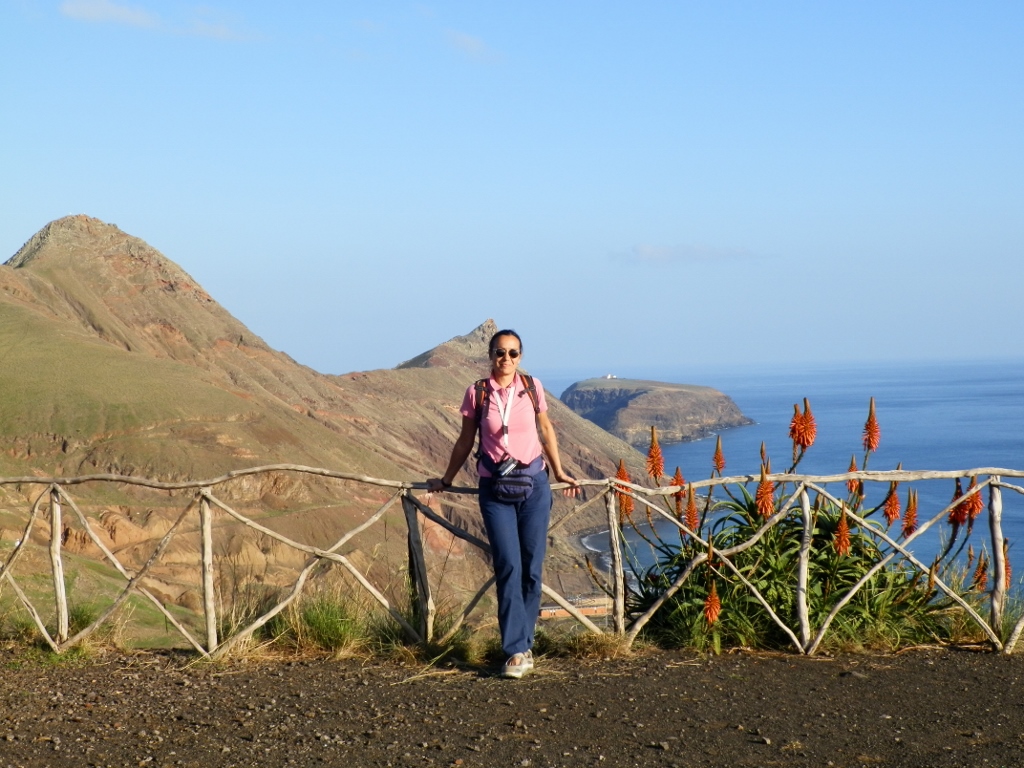 Portela Viewpoint: view at the east side of the island and there are also blossoming candelabra aloes
Portela Viewpoint: view at the east side of the island and there are also blossoming candelabra aloes
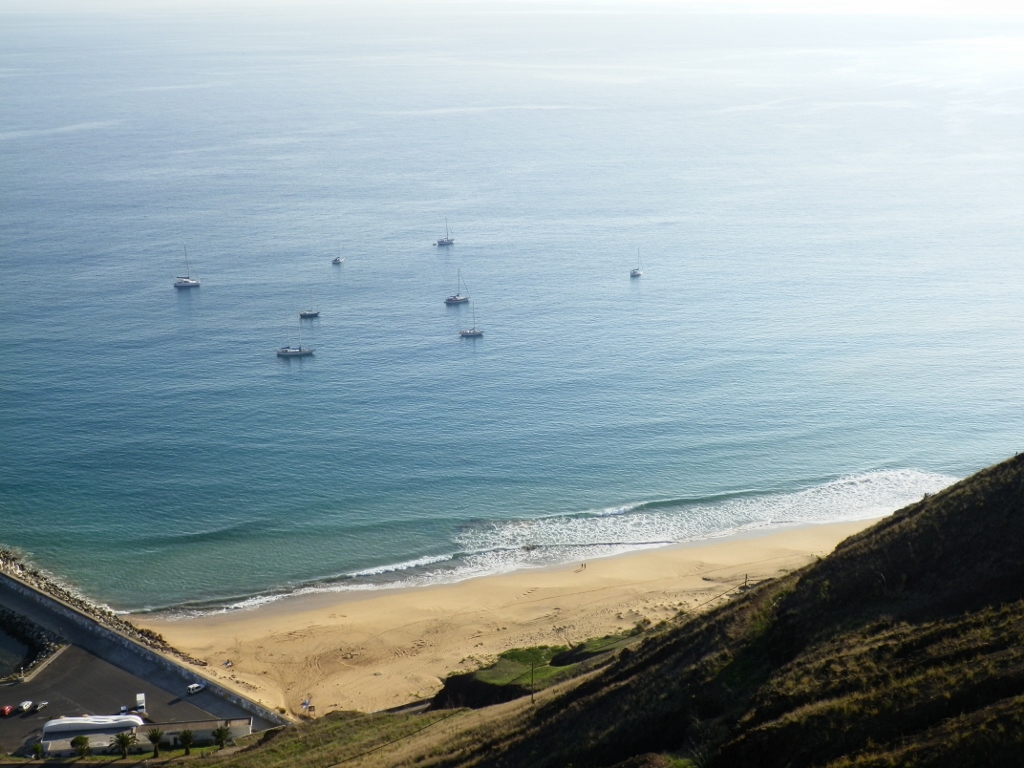 Beginning of the breakwater and the place where the Beach on Porto Santo starts
Beginning of the breakwater and the place where the Beach on Porto Santo starts
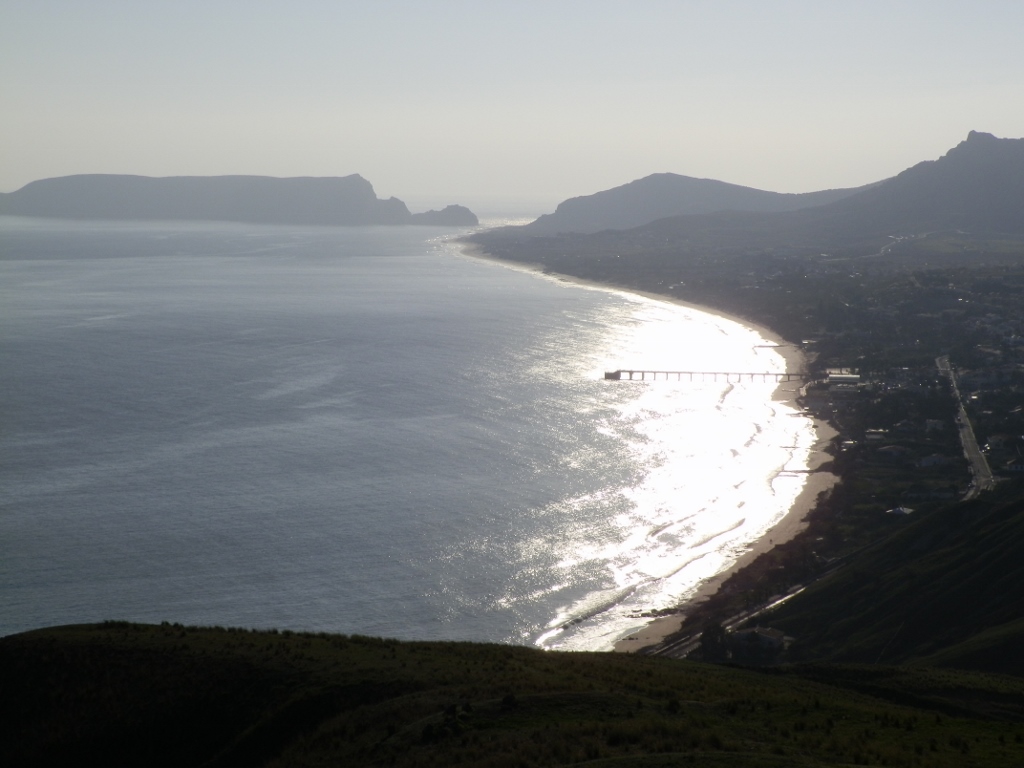 Portela Viewpoint: view at the beach as well as Cal Islet
Portela Viewpoint: view at the beach as well as Cal Islet
On the other side, towards the interior of the island, I could see the Porto Santo’s Windmills (Moinhos de Vento do Porto Santo). It is presumed that the first windmill for grinding cereals was built on this island at the end of the 18th century and at some point there were almost 40 of them. Today they are no longer used, but they are certainly one of the elements of the cultural heritage of Porto Santo.
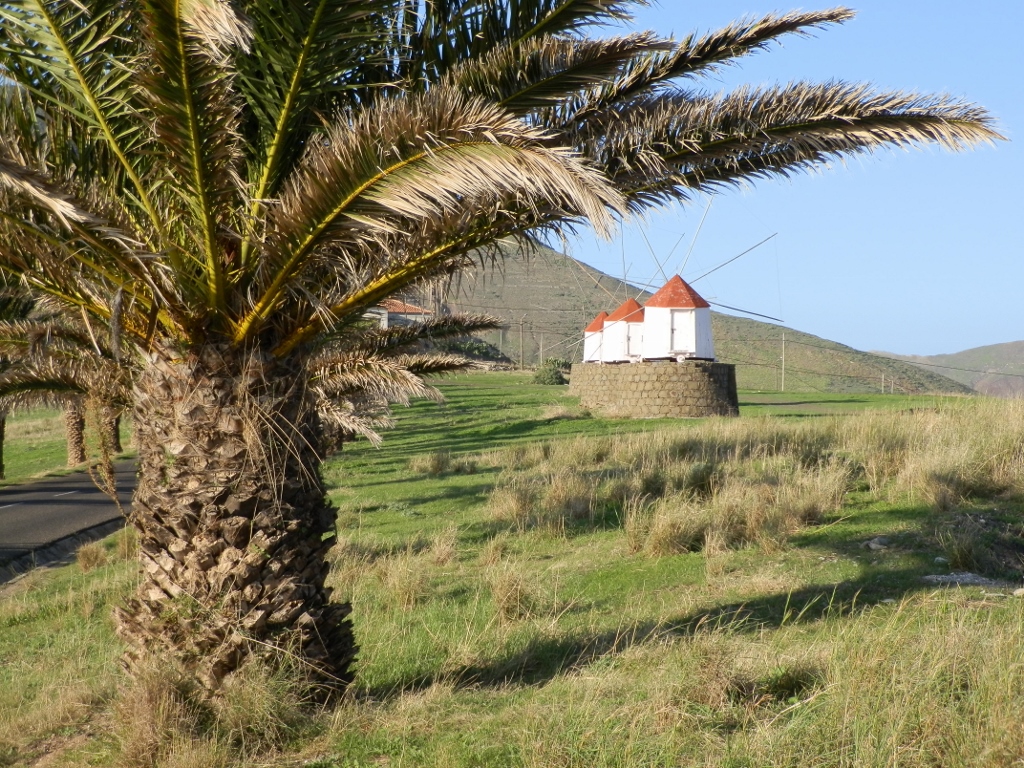 Porto Santo’s Windmills
Porto Santo’s Windmills
So, here we practically finished with our tour of Porto Santo island. An hour later we were already back on the ship and the Sun had set.
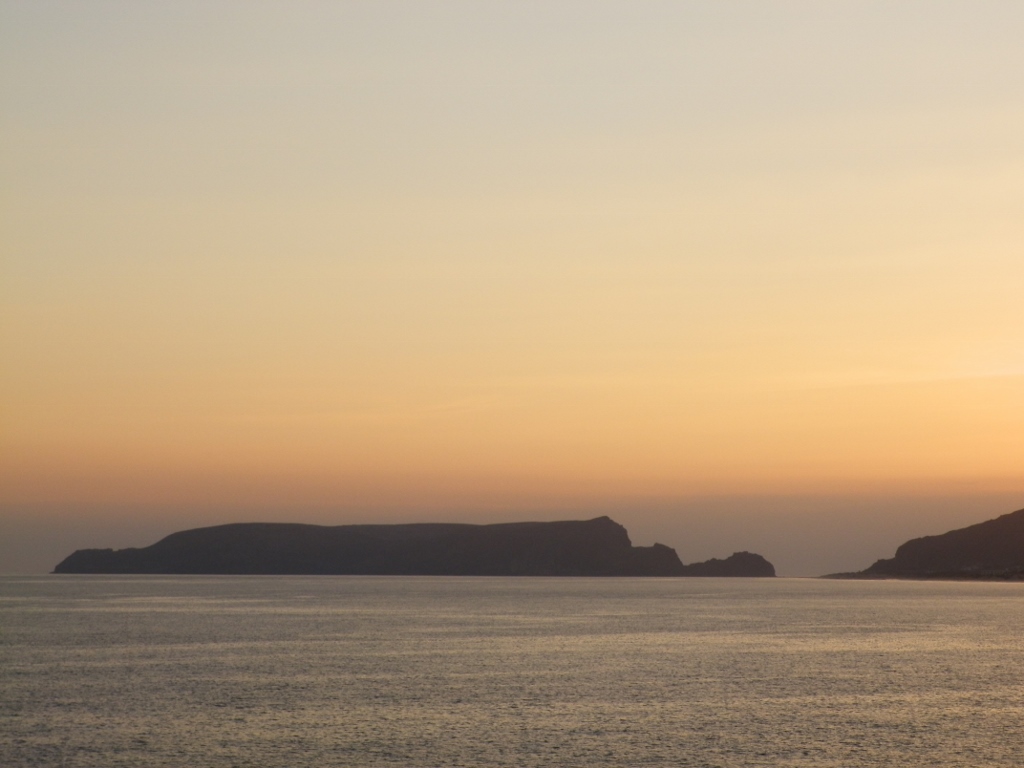 Cal Islet at dusk
Cal Islet at dusk
The return was in the dark, but not complete, for it was the night of the full Moon. I happened to know this in advance, so I was looking for it and eventually I found it.
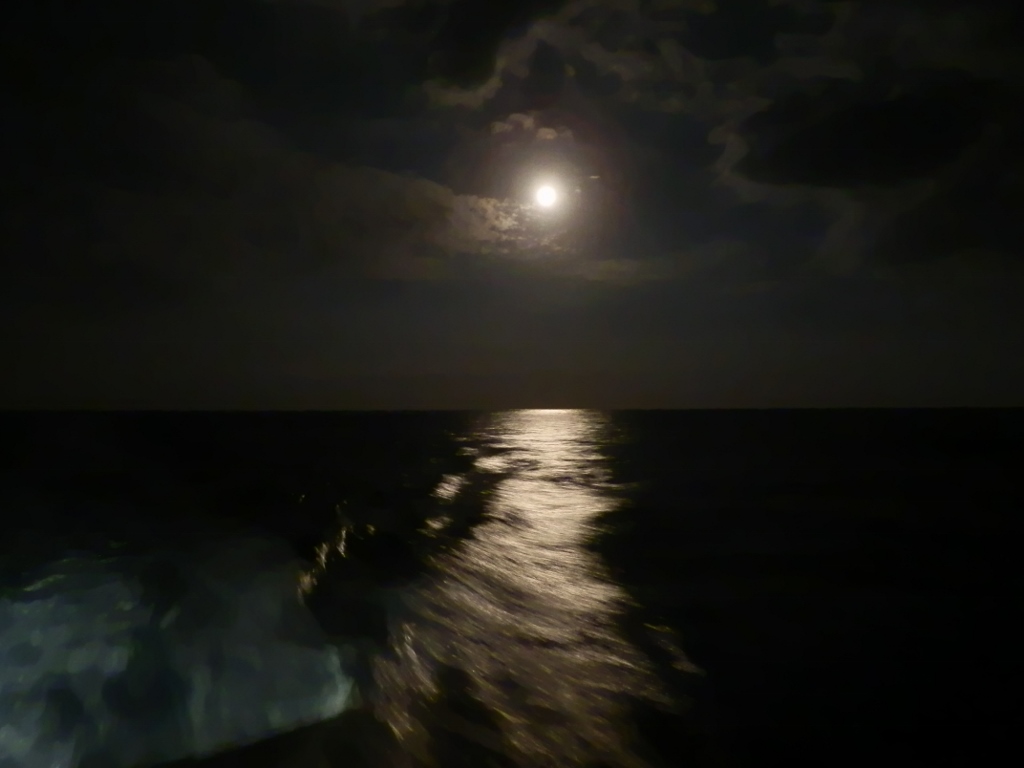 Sailing on the night of the full Moon
Sailing on the night of the full Moon
When we returned to Funchal, Joao and I went to meet Margarida, former Joao’s girlfriend with whom he still kept being friend and that was so nice to see. Couples usually stay together until the moment when they start to hate each other. This was a refreshing and pleasant situation to see and we spent some nice and fun time that evening.
The following morning I got ready in no hurry and I even read a little sitting on the terrace in front of my room and beside the pool, and then Joao came to pick me up, so we went for coffee and cakes at Palheiro Golf club above Funchal. The views were spectacular and the cake and the coffee were not bad either!
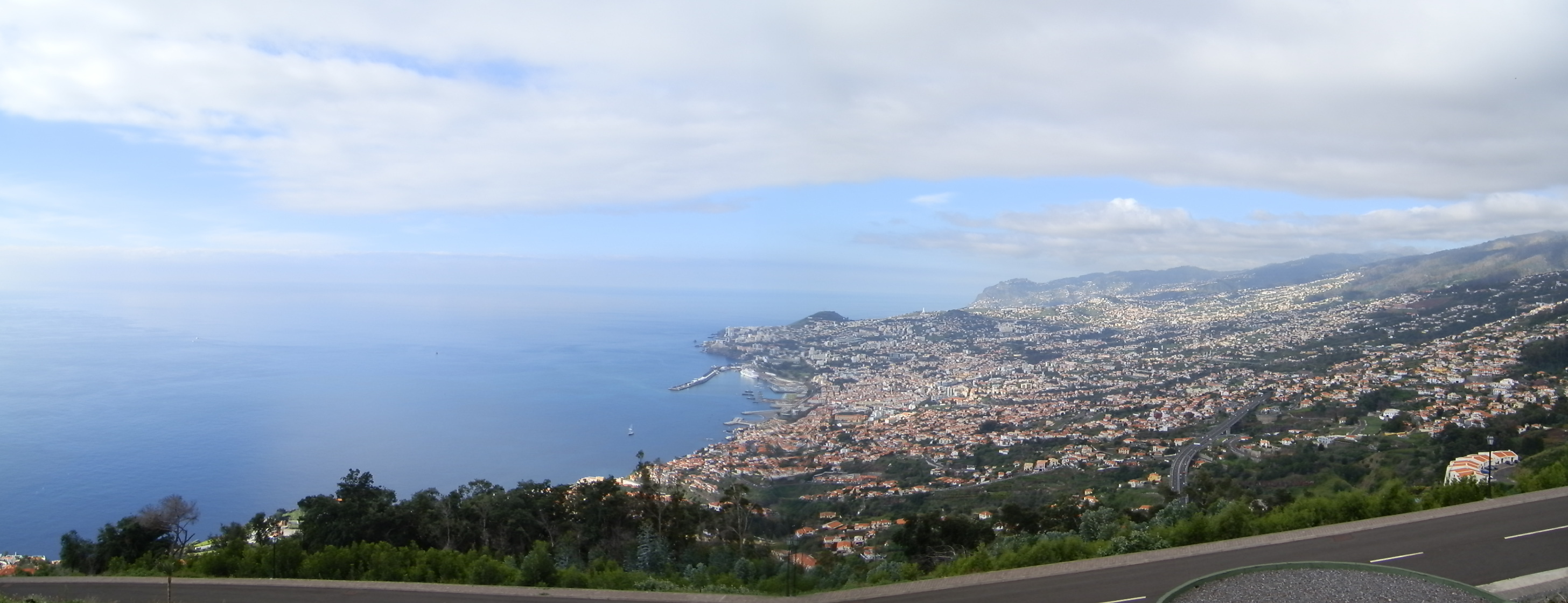

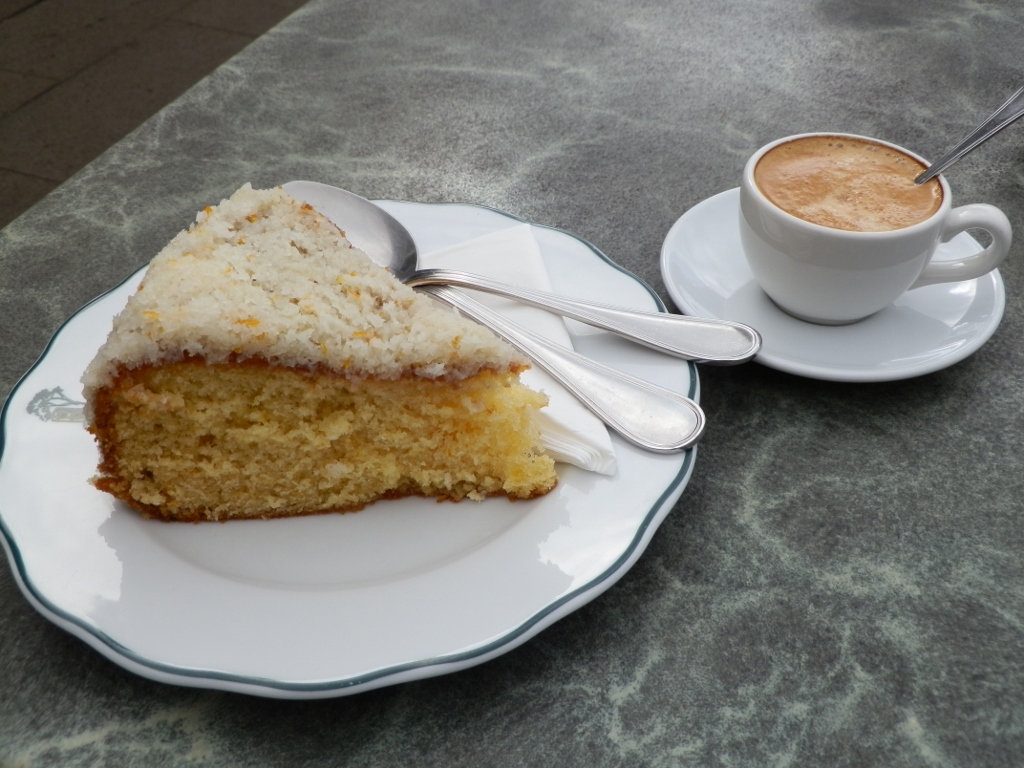 Cake and coffee at the golf club
Cake and coffee at the golf club
Afterwards we went downtown and walked around a little. There are many pedestrian streets in Funchal and they have interesting pavements...
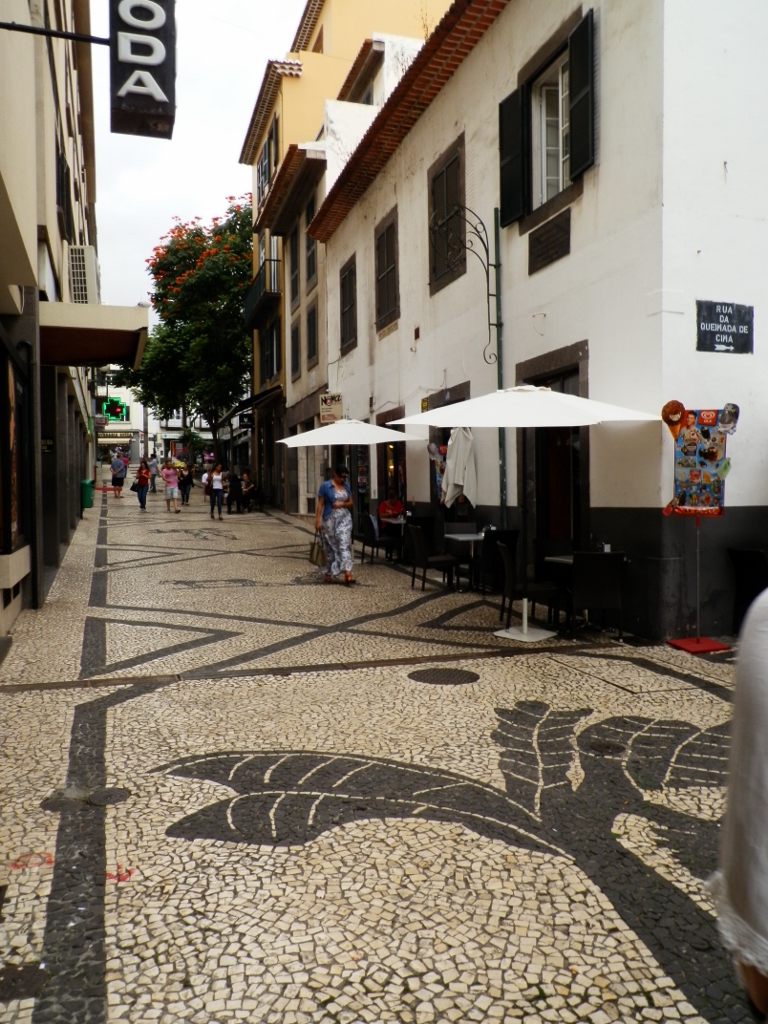 Walking street in Funchal
Walking street in Funchal
... beside the Cathedral that lady was still selling gorgeous flowers ...
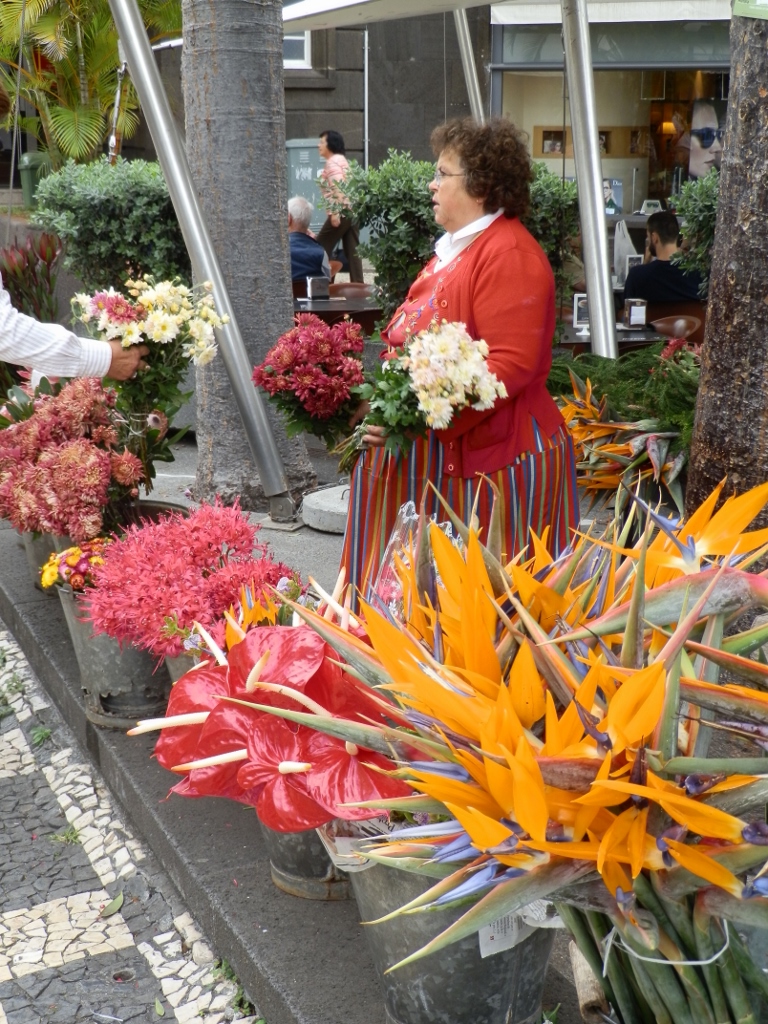 Will you buy some flowers?
Will you buy some flowers?
... and Joao and I sat in a café again to have coffee and cakes (one can never have too much of a good thing). Then a colleague of his came by, so she joined us and thus we spent some more of nice time.
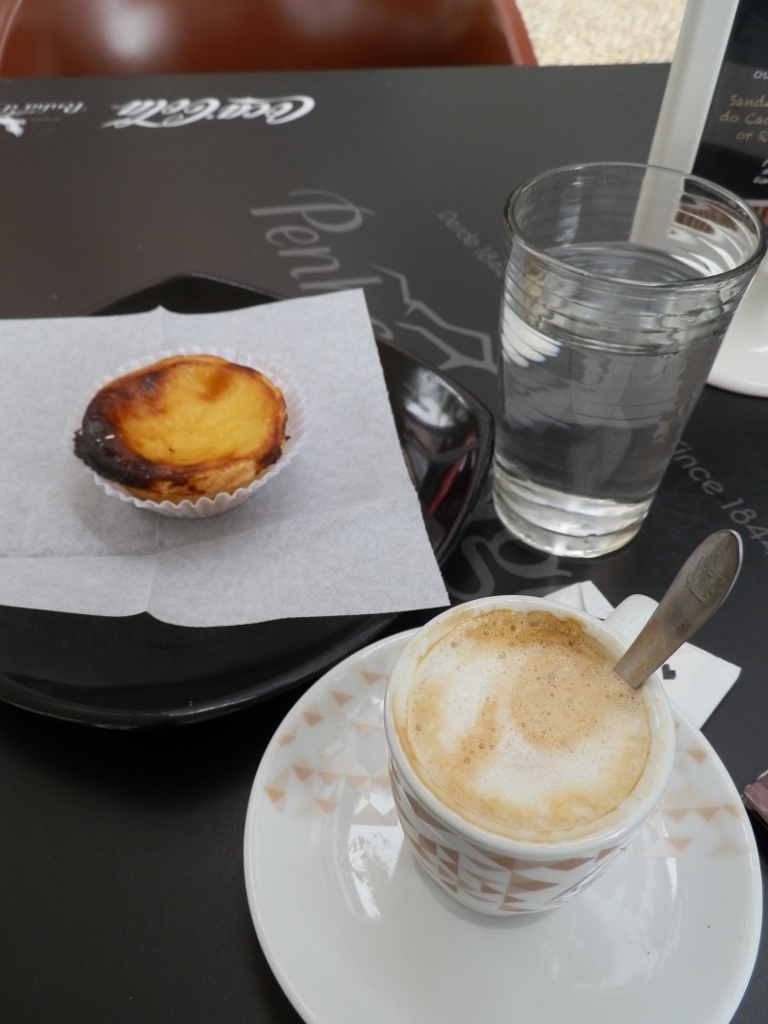 Pastel de nata is my favourite
Pastel de nata is my favourite
At some point Joao and I parted with an agreement to meet again later in the day. I still needed to buy a few things and I wanted to start packing. No matter how much I travel, I always find the packing stressful. I also wanted to have a rest and relax a little as a preparation for the return home the following day which again entailed three separate flights and an entire day of travelling or waiting at airports. Still, later in the afternoon I realised I did not feel like staying in my room any longer, so I went out for some more walking.
Along the way I kept seeing some new, as well as some old sights, and they all seemed interesting. For instance, an impressive ombú tree (Phytolacca dioica) famous for making a good shade, but I was mostly impressed by its section between the root and the trunk.
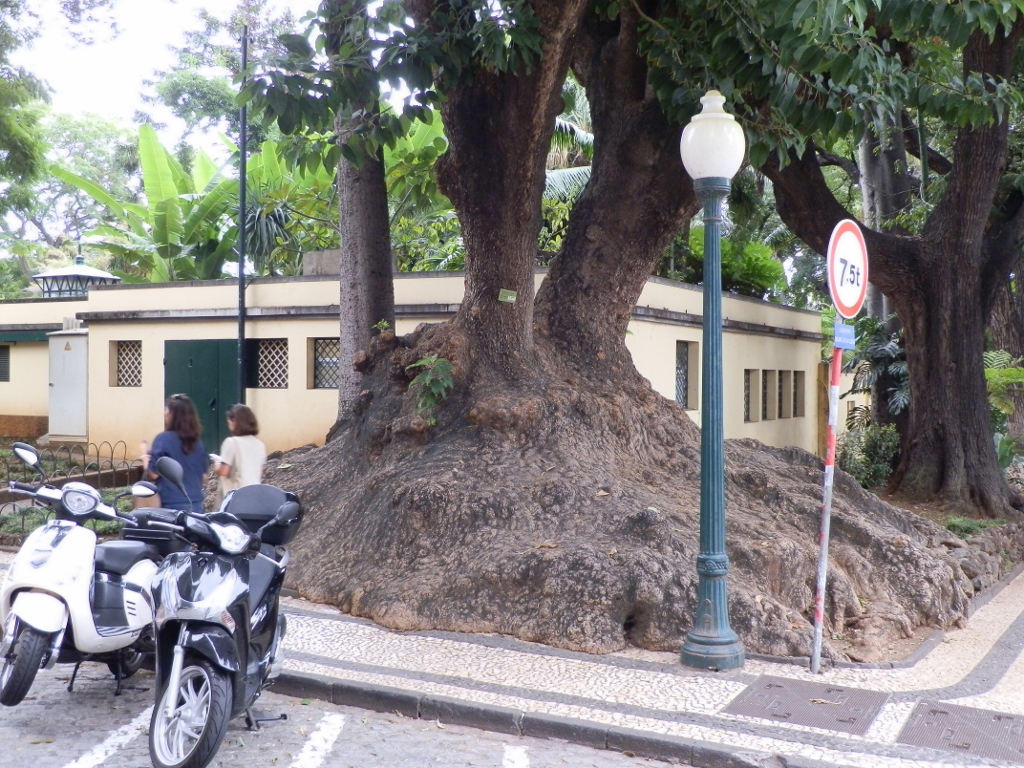 Ombú tree
Ombú tree
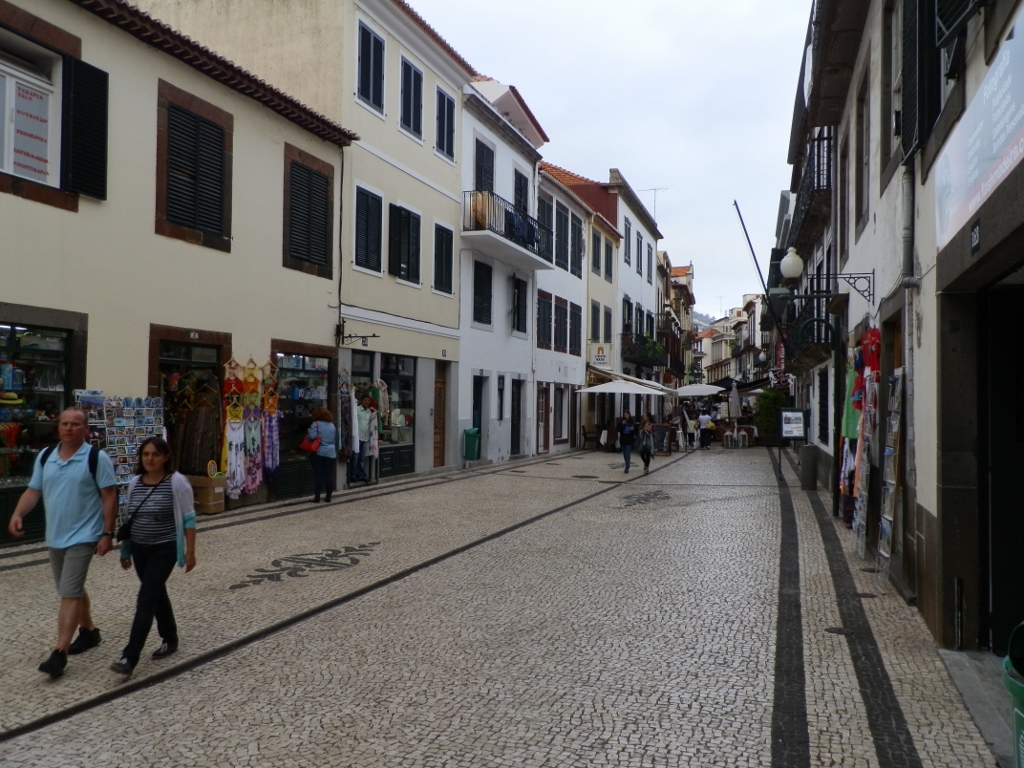 Another pedestrian street
Another pedestrian street
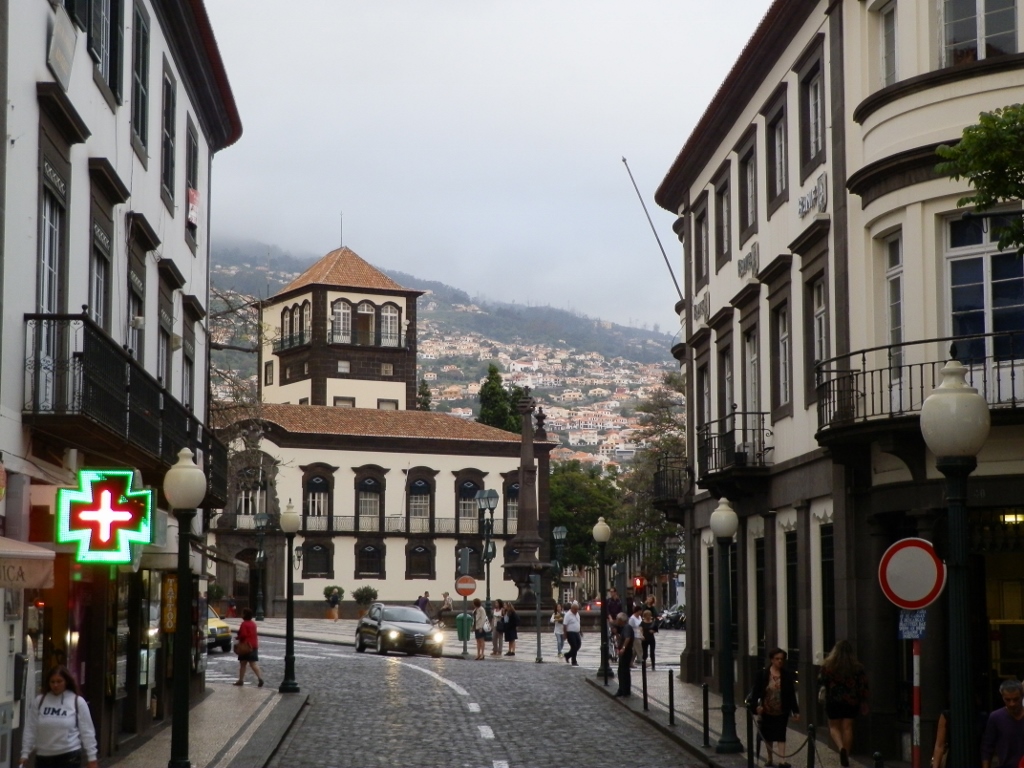 Municipal Square
Municipal Square
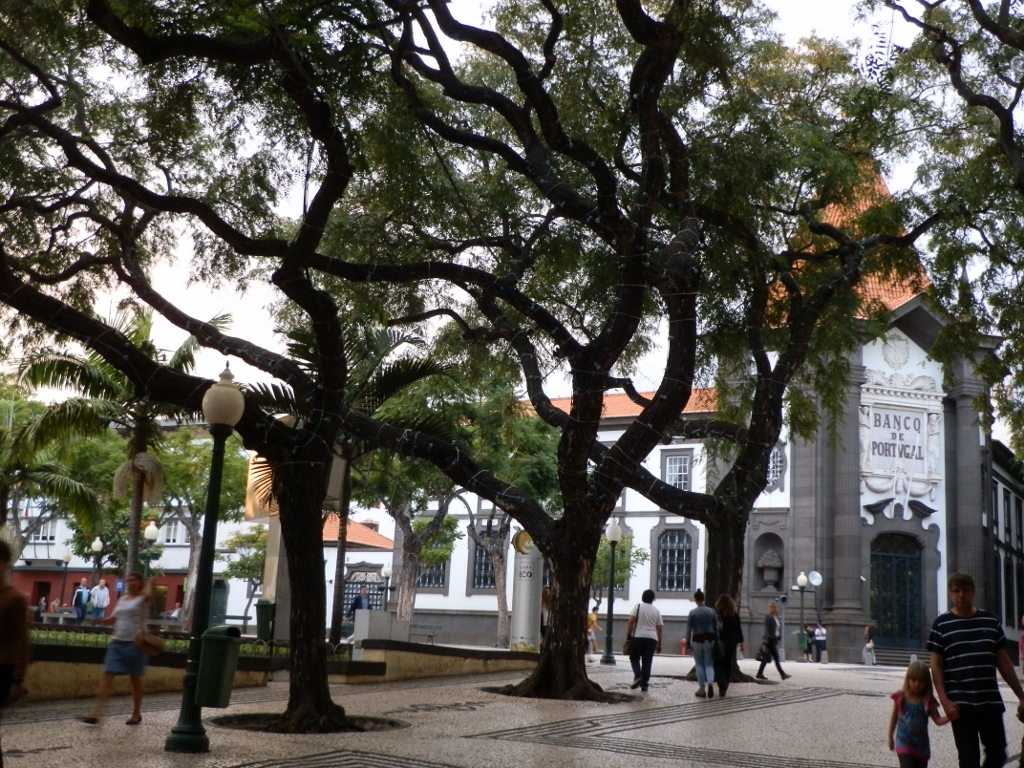 Bank of Portugal
Bank of Portugal
And then I met with Joao and we went again for a dinner at the same restaurant where I had eaten so well a couple of nights before. This time I ordered – EVERYTHING! I took traditional bread from Madeira – bolo do caco (garlic and butter flat bread). Then came the cold starter, followed by the warm starter and the main dish. I consoled myself saying this was all light food and anyway the following day I would certainly not eat much on the planes and at the airports.
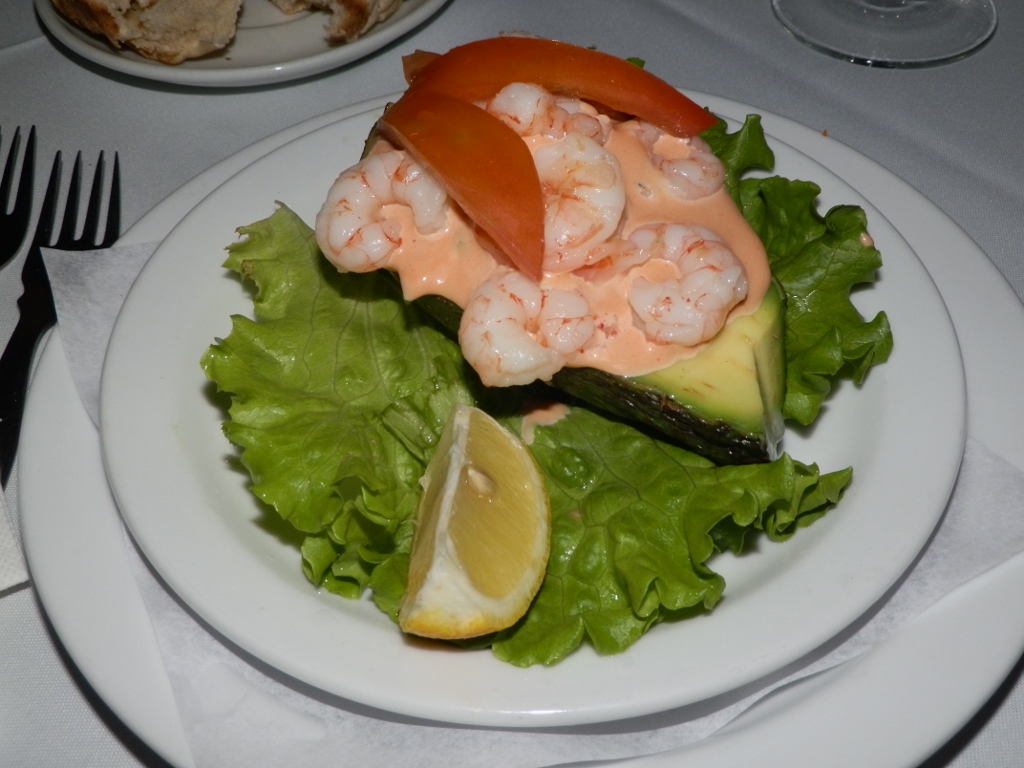 Avocado with shrimps
Avocado with shrimps
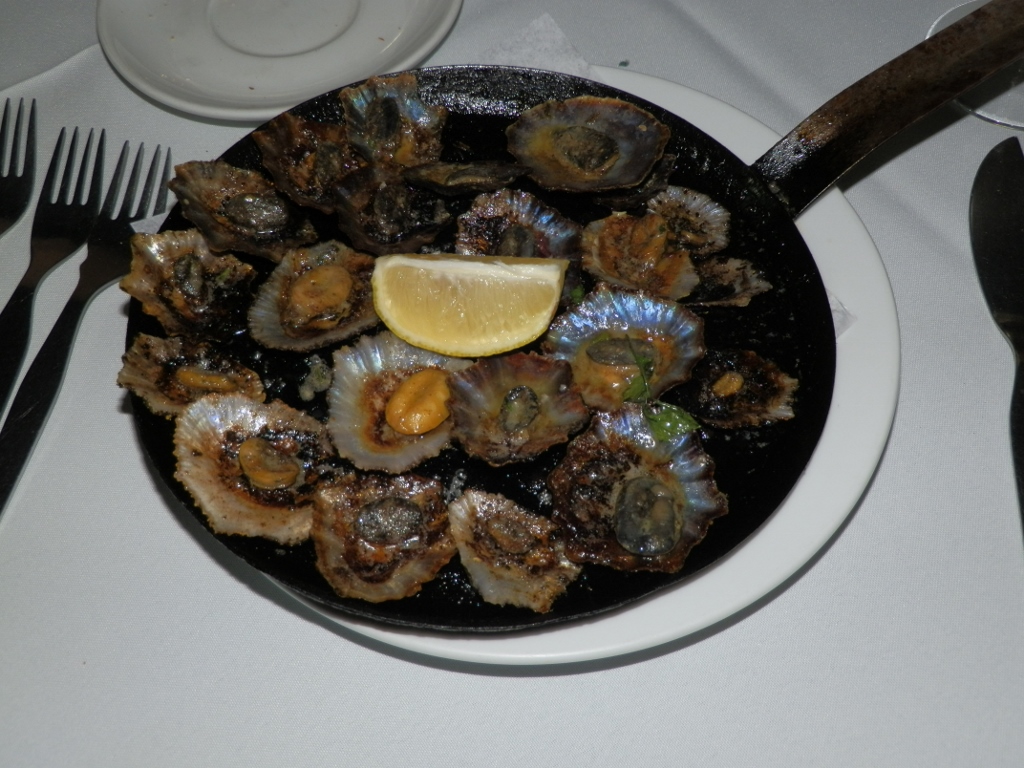 Patella
Patella
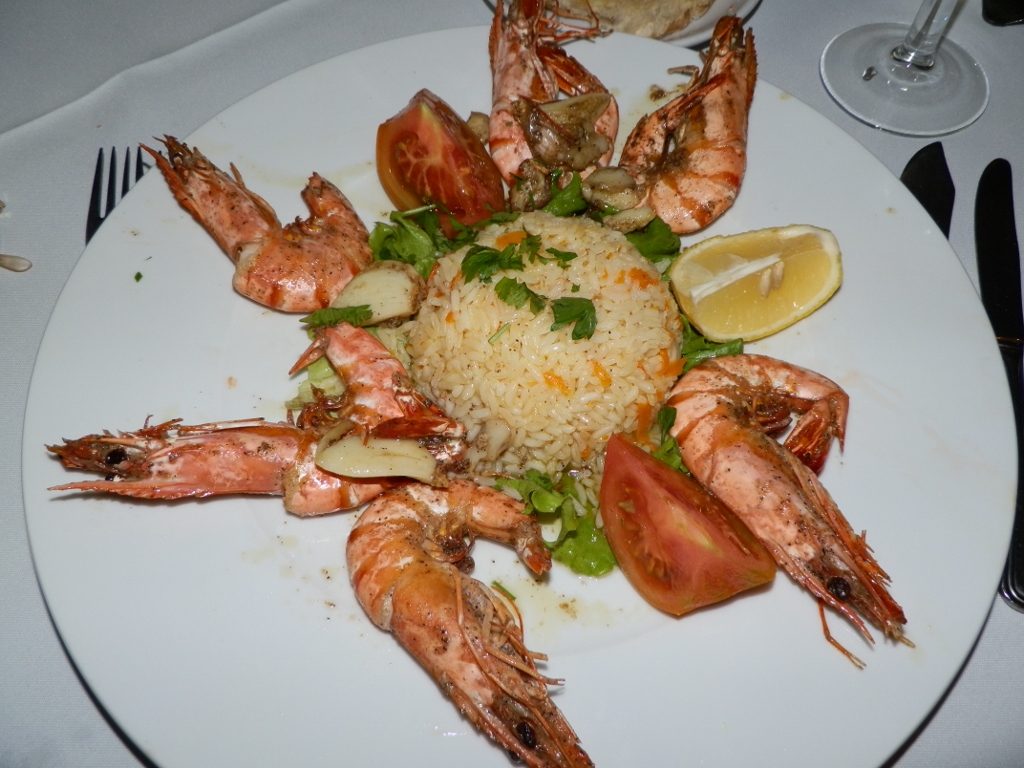 Shrimps with risotto
Shrimps with risotto
Although the food element obviously should not be neglected, a particularly important fact was that this was the last evening for Joao and me. The companionship with him was MARVELLOUS – unexpected, exceptionally pleasant, fun, relaxing and as if we had always known each other ... He is a truly fantastic human being, one of the best amongst us. And, as if everything he had done for me during the previous days was not enough, he insisted that the following morning it should be him to pick me up at the hotel and drive me to the airport. Well, that was something I could not accept, for I had to leave the hotel already around 5 am and although he claimed to be an early-riser, in the end he had to accept that I would take a taxi.
At the end of these stories about my travel in Madeira here is once again the map that shows all the places I visited during my stay:
The overall impressions I took with me came down to a very simple one – Madeira is a fantastic island – the landscapes and nature are gorgeous, the climate is very good and pleasant, the food and drinks are great, the history and heritage interesting and the older parts of Funchal are splendid!
This was the trip I wanted to take for a long time and in the end I thoroughly enjoyed it. I came here extremely tired and exhausted with overwhelming quantity of work just before the trip, plus my luggage did not come at the same time as I. In other words, everything seemed bad at first. But, the relaxing, no pressure or stress about anything, enjoying in different places I visited, in the food, coffee and fine weather, not to mention the great company of Joao, all of this made me feel incomparably better in the end.
But still... Without any desire to spoil anything now, because during this week everything was practically perfect, I am left with wishing there were a better connection between Belgrade and Funchal and that I could meet my wonderful friend Joao as often as I would like to. And, if we were to meet more often, who knows, maybe in the end I would learn how to pronounce Portuguese correctly.